99% of businesses now rely on at least one SaaS application.
That stat isn’t surprising when you consider how fast operations move today.
From onboarding new hires to syncing sales data across platforms, modern teams can’t afford clunky systems or manual workflows.
SaaS tools step in to bridge the gaps—cleaner processes, faster turnarounds, and less human error.
But with thousands of tools on the market, choosing the right ones can feel overwhelming.
That’s why we’ve narrowed it down to 50+ SaaS tools that actually help you work better, not just look good on a dashboard.
Need a powerful solution for managing social media without the clutter?
Here are the tools redefining productivity in 2025.
CTA: Tired of Manual Posting? Automate It with Social Champ
Schedule posts across all major platforms, recycle top content, and manage everything from one smart dashboard. Free up your day without missing a post.
Short Summary
- SaaS tools help businesses automate, simplify, and scale everyday operations across departments like HR, finance, marketing, and support.
- In 2025, cloud-based platforms are essential for efficiency, remote collaboration, and real-time data access.
- Social media management tools like Social Champ streamline scheduling, analytics, and engagement in one dashboard.
- Financial tools such as QuickBooks and Xero automate accounting tasks, improve accuracy, and save time on reporting.
Customer support platforms like Zendesk and Intercom enhance communication, ticketing, and user experience across channels. - Choosing the right SaaS stack depends on your business size, workflow complexity, and specific bottlenecks.
What Are SaaS Tools and Why Do They Matter in 2025?
SaaS (Software as a Service) tools are cloud-based software applications delivered to users over the internet, typically through a subscription model.
Instead of downloading software to a local computer or maintaining complex on-premise infrastructure, users access SaaS tools via a browser or app, with everything hosted and managed by the service provider.
These tools cover a vast range of business functions—from CRM and project management to marketing automation, HR, accounting, and social media management.
Popular platforms like Salesforce, Zoom, Notion, and Social Champ are all examples of SaaS tools, offering easy access, constant updates, and scalability without technical complexity.
Why Do SaaS Tools Matter in 2025?
In 2025, businesses are operating in environments that demand real-time collaboration, remote accessibility, and rapid adaptability.
Traditional software simply wasn’t built for this. SaaS tools, on the other hand, are built for the cloud, for scale, and for speed.
With hybrid work now the default for many companies, teams need software that works anywhere, anytime. SaaS tools enable this by eliminating the need for physical installations, VPN access, or manual syncing.
They’re also deeply integrated into digital ecosystems—connecting with APIs, third-party apps, and automation platforms to centralize workflows and reduce tool-switching.
Moreover, the competitive landscape has shifted. Businesses need to respond to market changes, customer needs, and internal challenges almost instantly.
SaaS tools support this agility by allowing quick deployment, immediate feature access, and data-driven insights without waiting for quarterly IT upgrades or hardware procurement.
Featured Article: Is SocialBu Pricing Justified? Here’s What You’re Really Paying For
Key Advantages of SaaS Tools Over Traditional Software
-
Accessibility and Remote Work Compatibility
SaaS tools are accessible from any device with an internet connection, making them ideal for hybrid teams, freelancers, and global operations.
No physical servers or office-bound software required.
-
Low Upfront Costs and Predictable Pricing
Unlike traditional software that demands heavy licensing fees and infrastructure investments, SaaS tools operate on subscription-based models—monthly, annually, or per user.
This makes budgeting more predictable and entry barriers lower for small businesses.
-
Rapid Deployment and Scalability
Businesses can onboard SaaS platforms within hours or days, not weeks.
As needs evolve, these tools can scale up (or down) quickly by adjusting plans, adding integrations, or expanding features without major disruptions.
-
Automatic Updates and Feature Enhancements
With SaaS, users always get the latest version—no manual downloads or patching required.
Providers roll out improvements, bug fixes, and new functionalities regularly, keeping your business tools modern without IT intervention.
-
Integration and Workflow Automation
Most SaaS platforms integrate with other services (CRMs, ERPs, communication tools, etc.), enabling seamless automation.
This reduces the time spent on repetitive tasks and improves overall workflow efficiency.
-
Security and Compliance
Reputable SaaS vendors invest heavily in data protection, encryption, and compliance frameworks like GDPR, SOC 2, and HIPAA, offering enterprise-level security without the internal burden.
Top SaaS Tools for Social Media Management and Scheduling
In 2025, efficient social media management is vital for engaging audiences and driving growth.
Brands need to publish consistently, monitor conversations, and analyze performance—all while collaborating seamlessly across teams.
Below are the top-tier social media management and scheduling tools, each optimized for today’s digital demands.
-
Social Champ
Social Champ has become a powerful all-in-one platform for teams seeking smarter scheduling, multi-platform publishing, and simplified workflows.
It supports 11+ social networks, including Facebook, Instagram, X (Twitter), LinkedIn, Pinterest, YouTube, TikTok, Google Business Profile, Threads, Bluesky, Mastodon and even WhatsApp Business.
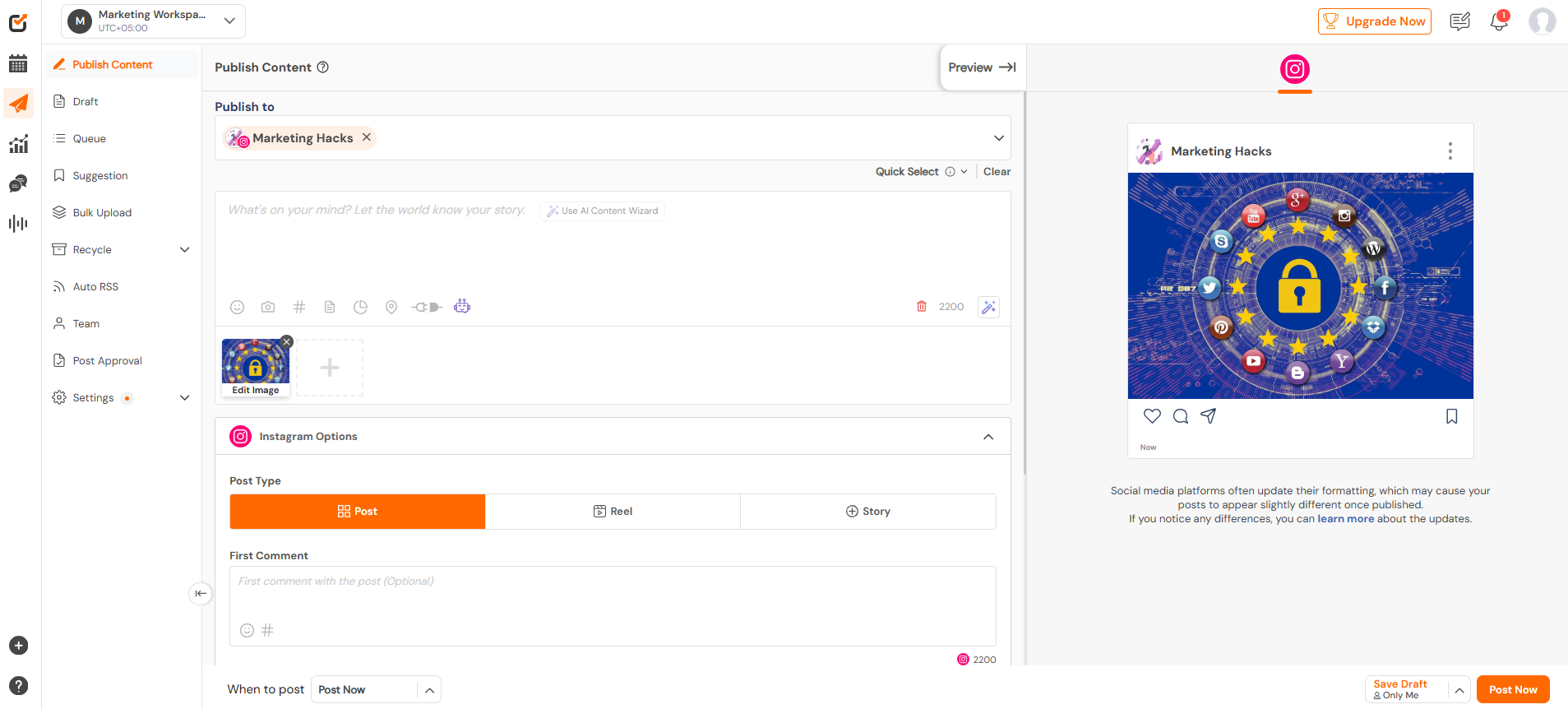
Social Champ’s Dashboard Key strengths
- AI-Driven Scheduling: From bulk uploading to AI-generated captions and auto-scheduling based on best times, Social Champ makes posting intuitive and efficient.
- Centralized Inbox: Engage with messages, comments, and mentions from all platforms in one inbox—ideal for avoiding tab fatigue.
- Team Collaboration: Built-in approval workflows, content queues, and post-level access settings help teams stay aligned.
- Robust Analytics: Generate detailed reports, track engagement, monitor competitors, and measure campaign performance with visual insights.
- Ease of Use: The interface is clean and beginner-friendly, making it accessible even for small business owners with limited marketing experience.
- Affordability: Compared to legacy tools, Social Champ offers significantly more value for lower-tier pricing, with powerful features even on its free plan.
Usage experience: Users frequently praise its smooth publishing workflow, responsive customer support, and fast UI. While mobile app enhancements are underway, the desktop version offers a full suite of capabilities that rival bigger platforms.
CTA: Running Multiple Brands? Keep It Clean.
Switch between workspaces, assign team roles, and control approvals without the clutter or confusion only with Social Champ! Try Now!
-
Hootsuite
As one of the earliest players in social media management, Hootsuite continues to dominate the enterprise and mid-market space with its versatile platform.
It supports scheduling, social listening, analytics, and ad management from one centralized dashboard.
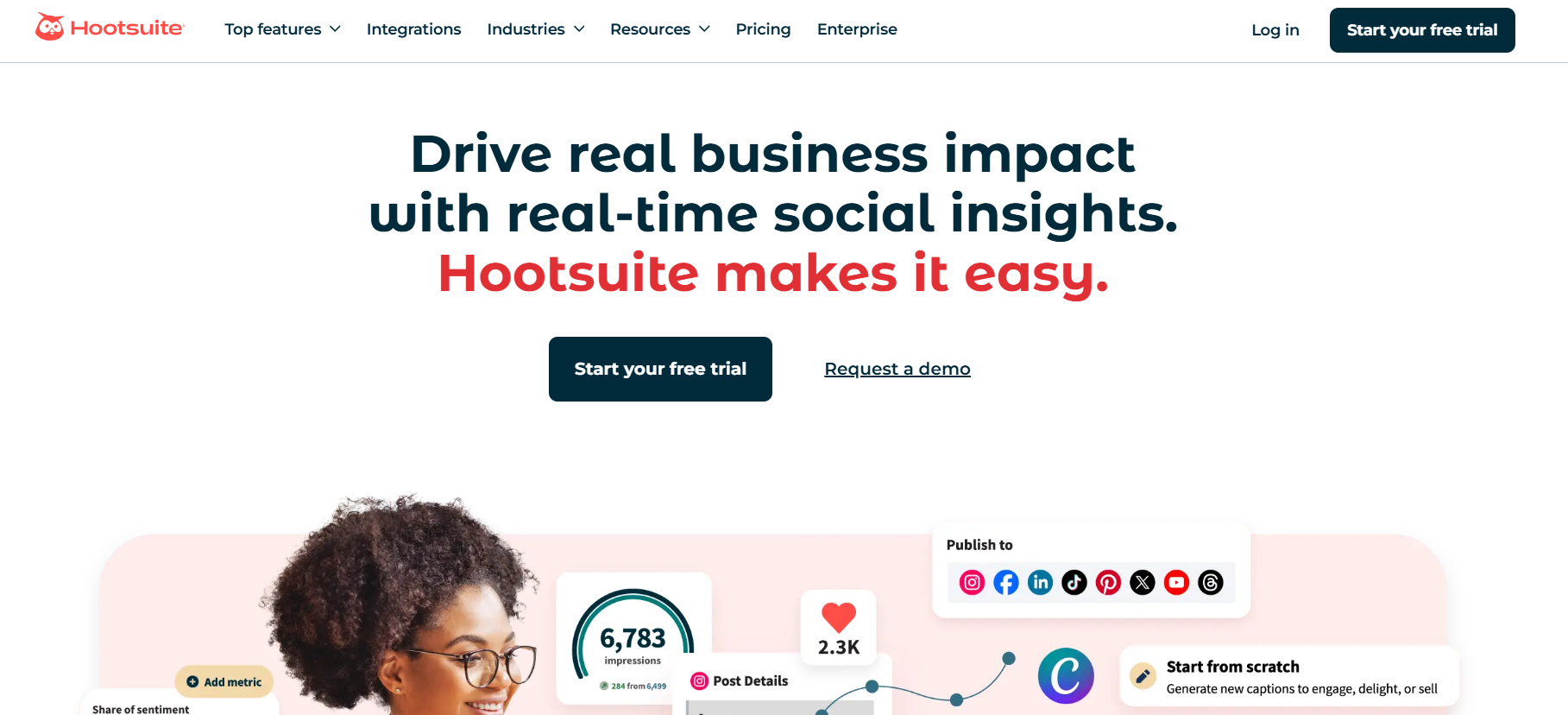
Hootsuite Landing Page Core features
- Monitor conversations, hashtags, and competitor activity in real time through custom “streams.”
- Plan posts manually or use Hootsuite’s auto-scheduler to post during high-engagement windows.
- Enterprise-level permission controls, content approval processes, and role assignments streamline collaboration across large teams.
- In-depth dashboards allow users to measure performance, benchmark competitors, and attribute social metrics to revenue.
Usage Experience
Hootsuite offers depth, but the learning curve can be steep for new users. Large organizations benefit most from their customizability and workflow automation. However, its pricing is generally higher than smaller tools, which might be a barrier for solopreneurs and small teams.
-
Buffer
Buffer has long been the go-to choice for startups and small teams wanting a minimalist, user-first social media management solution.
It supports key platforms and focuses on ease of publishing, analytics, and light collaboration features.

Buffer’s Dashboard Key highlights
- Queue content easily by setting posting times per platform. Drag-and-drop calendar functionality makes planning intuitive.
- Track clicks, engagement, and growth over time with straightforward visual reports.
- Assign roles, share drafts, and get approvals without overcomplicating your workflow.
- Buffer also offers AI suggestions and RSS integrations to help users fill their content calendar with minimal friction.
Usage Experience
Buffer excels in its clean interface and no-frills workflow. It’s often favored by content creators and marketing teams that don’t need overly complex dashboards.
-
Sprout Social
Sprout Social is a premium tool offering robust features tailored for growing companies and agencies that need performance insight, client management, and scalable collaboration.
It balances powerful analytics with an excellent user experience.
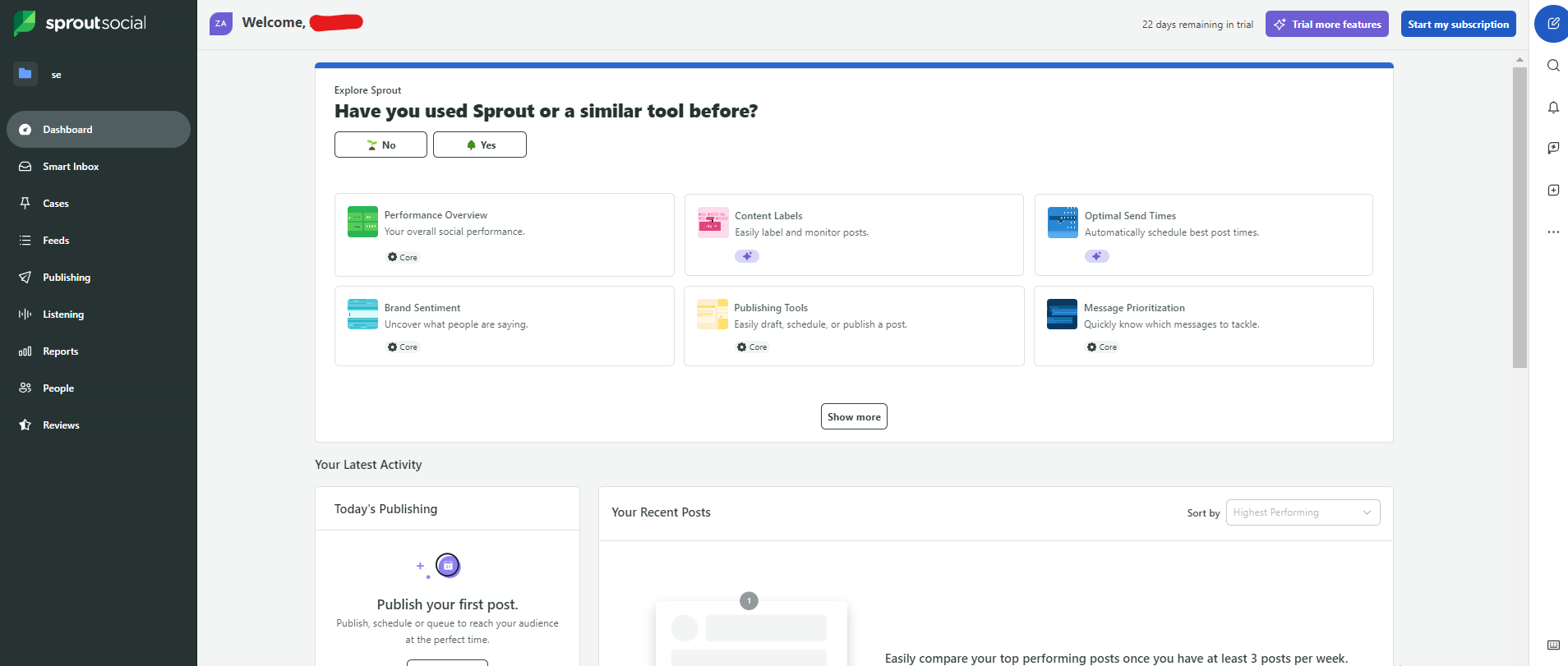
Sprout Social’s Dashboard What it offers
- Plan, post, and auto-optimize content across networks from a unified publishing calendar.
- Manage all social messages, comments, and DMs in a single, filterable inbox.
- Generate presentation-ready reports, benchmark competitors, and evaluate engagement trends by campaign or profile.
- Approvals, task assignment, and content libraries support streamlined teamwork.
Usage Experience
Sprout Social is known for its polished design and ease of use, even with complex data. Pricing is on the higher end, but it’s justified by the depth and polish of its feature set, particularly for teams needing multi-layered access and stakeholder reporting.
-
Agorapulse
Agorapulse is another well-rounded SaaS tool that caters to agencies and growing teams needing strong collaboration, engagement, and reporting features.
It emphasizes structure and visibility in both publishing and communication.
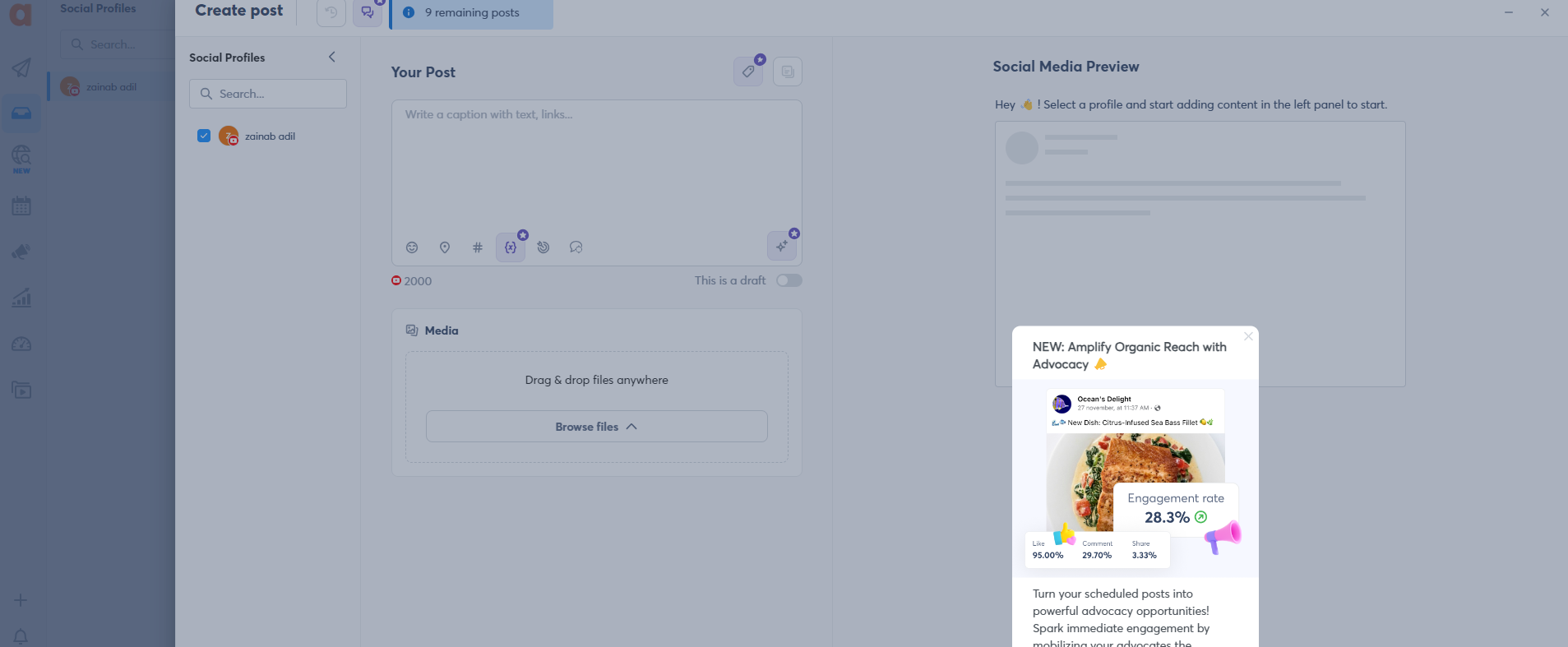
Agorapulse’s Dashboard Key Features
- Easily visualize content campaigns across profiles with drag-and-drop scheduling.
- Respond to comments, DMs, and mentions from all platforms in one clean inbox—ideal for busy social teams.
- Assign, review, and approve posts in a structured flow, keeping content governance tight.
- Offers rich analytics and white-labeled reports perfect for agencies or consultants managing multiple clients.
Usage Experience
Agorapulse strikes a balance between feature depth and usability. While it doesn’t offer as many third-party integrations as larger platforms, its focused feature set is reliable, fast, and thoughtfully designed for collaboration.
-
Later
Later started as an Instagram-focused scheduler and has since evolved into a visual-first social media management platform supporting Facebook, Pinterest, TikTok, LinkedIn, and X (Twitter).
It’s widely adopted by brands that prioritize aesthetics and content planning at scale.

Later’s Dashboard Key highlights
- Drag-and-drop content into a calendar for a highly visual approach to scheduling, especially effective for Instagram and Pinterest.
- Centralized storage for all images and videos with labels, notes, and usage tracking to streamline content reuse.
- Create a clickable, shoppable landing page tied to your Instagram grid—ideal for e-commerce and influencer accounts.
- Schedule short-form video content and manage hashtags and captions within the same flow.
Usage Experience
Later stands out for teams focused on visual storytelling. Fashion brands, lifestyle influencers, and small shops love how it turns content planning into a visual process. The platform feels more creative and less technical, making it a great fit for non-marketers.
-
Metricool
Metricool is a data-driven social media tool that merges scheduling, analytics, competitor tracking, and ad management in one streamlined platform.
It’s built for performance marketers who want visibility across organic and paid efforts.
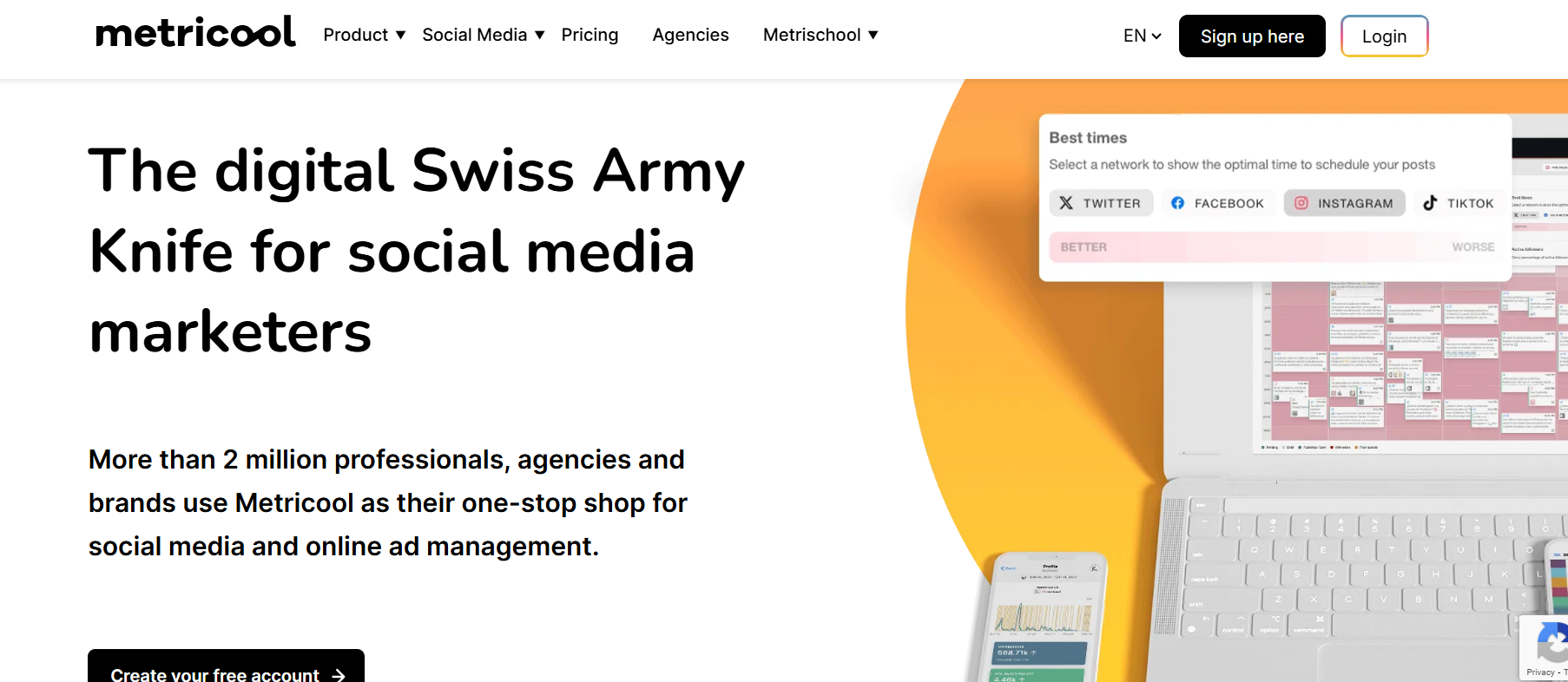
Metricool Landing Page Key Highlights
- Plan and automate posts across Facebook, Instagram, X, LinkedIn, YouTube, TikTok, and even Google Business.
- Monitor KPIs like impressions, clicks, engagement rates, and follower growth in a unified dashboard.
- Track and schedule Google Ads and Meta Ads within the same interface.
- Analyze rivals’ social performance and compare content strategy, frequency, and engagement.
Usage experience: Metricool is particularly strong in analytics—it provides a clear view of both social and ad campaign performance, which is rare in scheduling tools.
Essential SaaS Tools for Marketing Automation and CRM
In 2025, marketing automation and CRM platforms aren’t just optional—they’re mission-critical. They centralize lead generation, customer nurturing, analytics, and communications.
By automating repetitive tasks and personalizing customer experiences, these tools reduce friction, sharpen targeting, and improve ROI.
Let’s dive into five standout platforms dominating this space.
-
HubSpot
HubSpot Marketing Hub & CRM is an integrated powerhouse that merges marketing automation, content creation, email, social media, and analytics—all tied to a robust CRM.
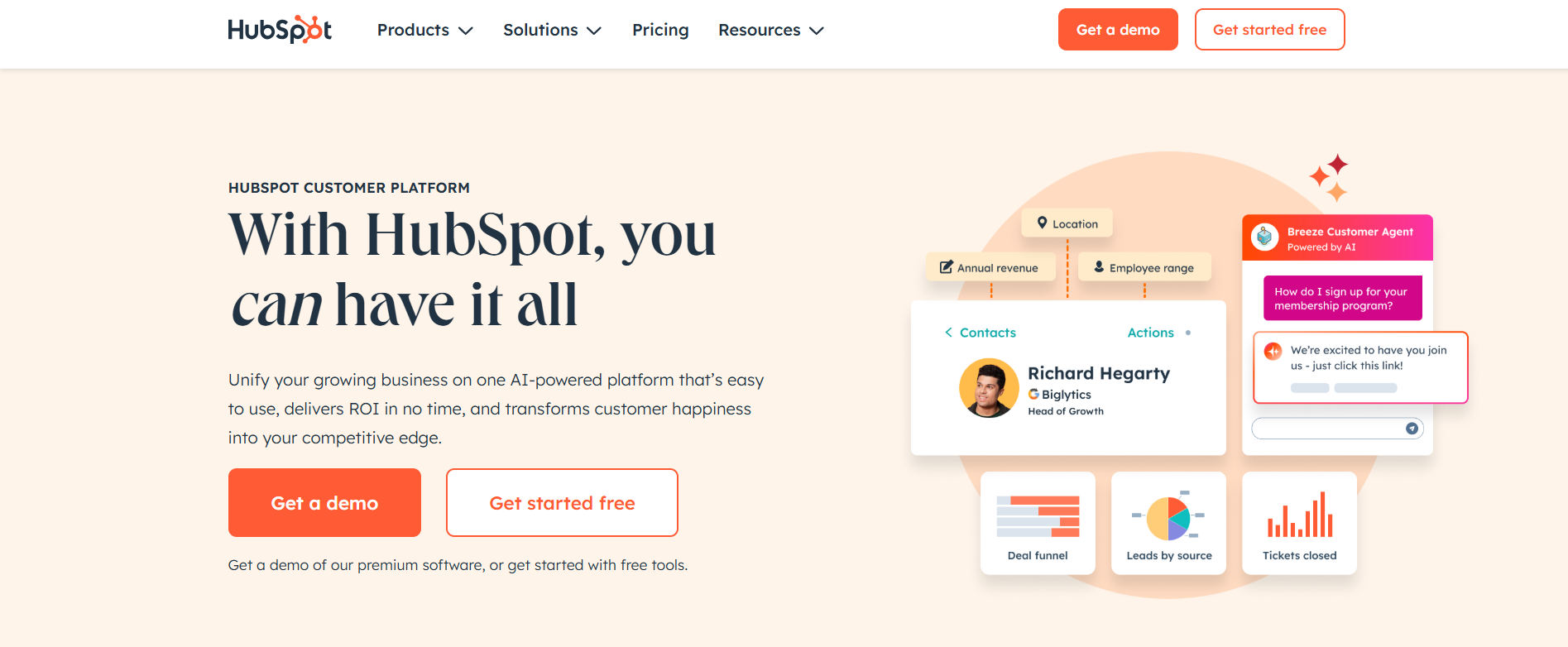
HubSpot Landing Page Key Features
- The drag-and-drop workflow builder allows marketers to trigger multi-step campaigns.
- Dynamic content driven by behavioral triggers and demographic data helps tailor emails, CTAs, and landing pages.
- This suite includes prospecting, content, customer support, knowledge-base bots, automating support, lead gen, and content creation.
- Send emails, SMS, run paid ads, deploy chatbots, and schedule social posts—then view all results in unified dashboards.
User Experience: Users praise HubSpot for its intuitive interface and seamless integration across marketing, sales, and service functions.
-
Mailchimp
Originally an email marketing tool, Mailchimp has evolved into a full-featured CRM with automation, predictive segmentation, and behavioral targeting.
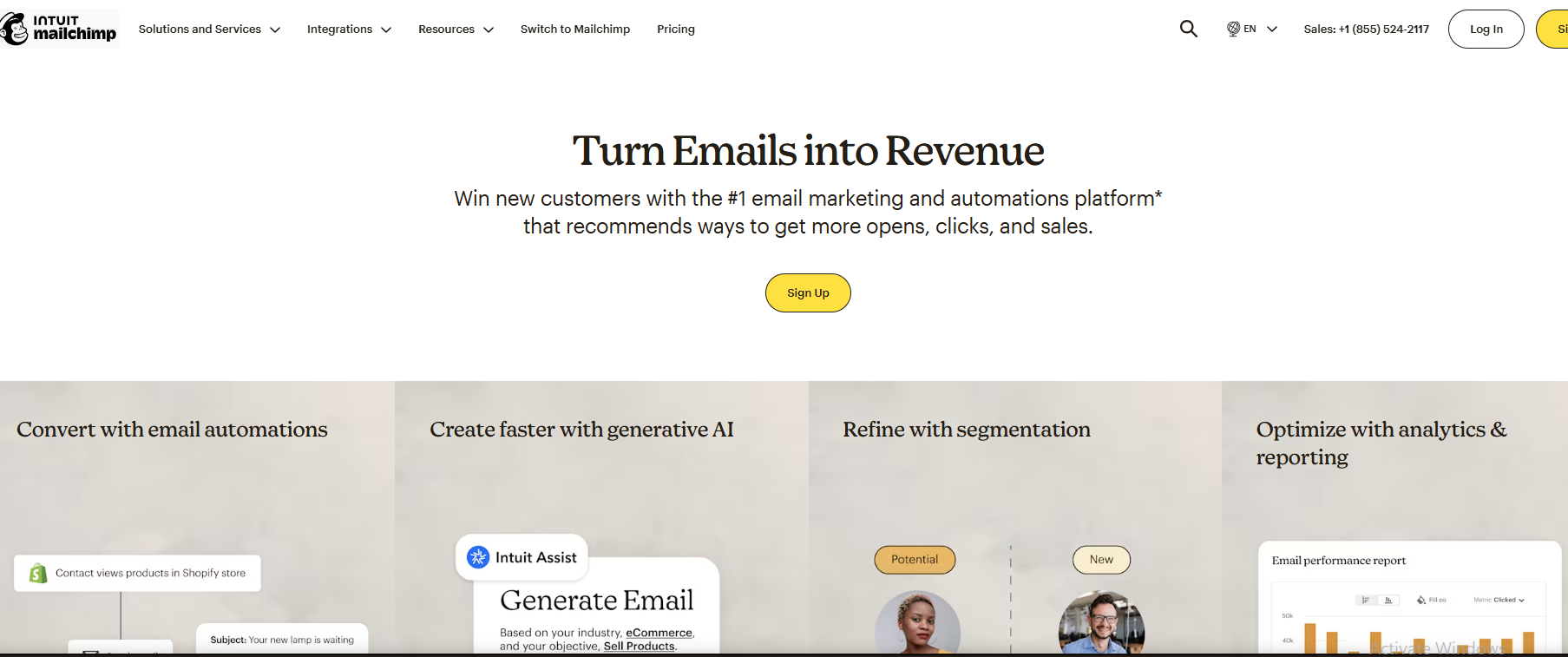
MailChimp Landing Page Core Capabilities
- Visual setup of customer journeys—welcome series, abandoned cart triggers, re-engagement campaigns—using drag-and-drop logic.
- Choose from over 100 responsive templates and customize via drag-and-drop.
- Automated content suggestions, branding tools, subject line optimization, and generative AI help produce and refine content quickly.
- Segment by behavior (opens, clicks, prior purchases) and demographics; automation adapts messaging for each segment
User Experience
Mailchimp is user-friendly yet powerful, catering to both novices and experienced marketers. Its automation journey builder is praised for its complexity without confusion.
-
Salesforce CRM & Marketing Cloud
Salesforce, the market leader in CRM, integrates AI-driven sales, service, and marketing automation.
With features like Flow Builder, Einstein AI, and Marketing Cloud, it serves enterprises seeking comprehensive customer engagement.
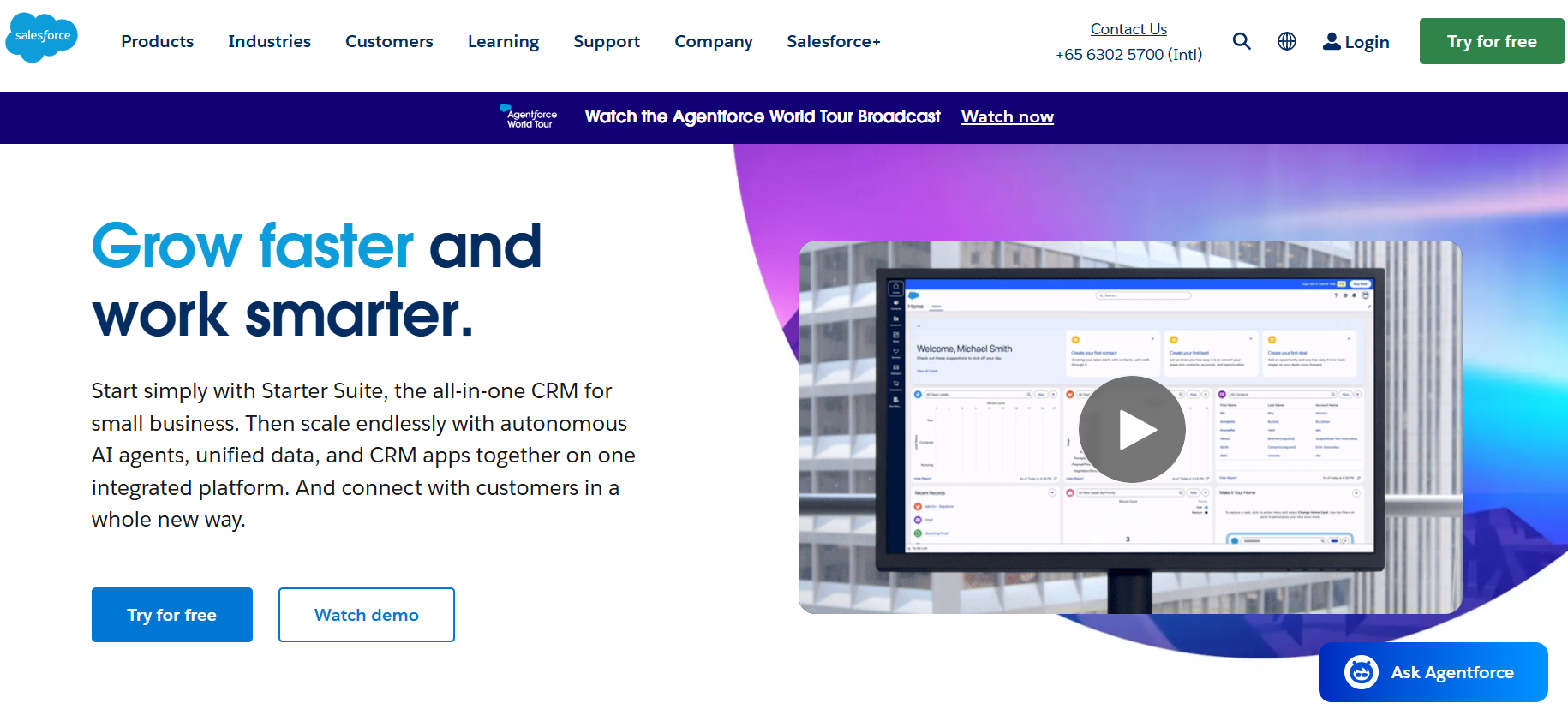
Salesforce Landing Page Feature Highlights & Experience
- Visual interface for automating sales, onboarding, support, email nurturing, and lead routing—without coding
- Predictive analytics, lead scoring, automated insights, plus AI “digital agents” for customer interactions and marketing tasks
- Unified platform for email, mobile, social, and advertising campaigns, plus customer journey mapping.
- Seamlessly connect marketing, sales, and support data for holistic personalization and service delivery.
User Experience
Salesforce impresses with deep automation and AI. Ideal for large corporations and complex data environments, though it requires more setup time and specialized resources.
-
ActiveCampaign
ActiveCampaign blends email marketing, CRM, and marketing automation into a single, high-performing platform—ideal for small to mid-size businesses seeking intelligent campaigns and sales automation.
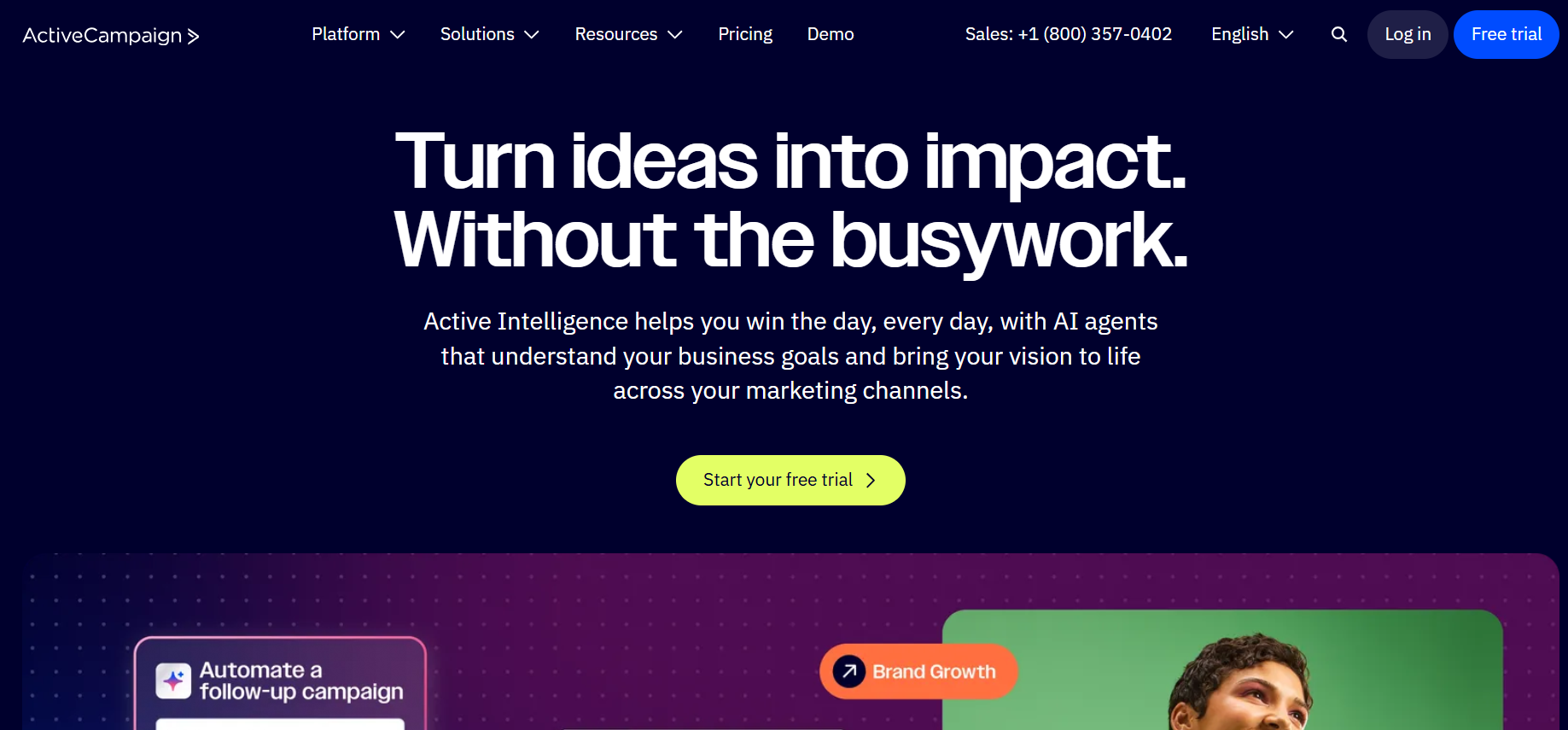
ActiveCampaign Landing Page Core Strengths & Experience
- Create behavior-based and conditional automations with email, SMS, site messaging, and CRM triggers.
- Sends communications at optimal times per contact, improving open and conversion rates.
- Leads are auto-assigned with scoring, notifications, and pipeline management aligned with marketing workflows.
- Intuitive drag-and-drop pipeline and automation flow builder streamline strategy.
User Experience
Known for stellar ease-of-use, ActiveCampaign is accessible yet powerful. Its automation landscape rivals higher-priced tools in feature depth.
-
Marketo Engage (Adobe)
Marketo Engage—part of Adobe Experience Cloud—is built for enterprise-grade B2B marketing, emphasizing account-based marketing (ABM), lead lifecycle management, and ROI tracking.

Marketo Engage Landing Page Primary Capabilities & Experience
- Use multi-step campaigns and score leads on engagement, effectively raising them through nurturing layers.
- Target high-value accounts with tailored campaigns across channels.
- Multi-touch attribution and revenue cycle modeling bridge marketing spend and sales return.
- Seamless data exchange allowing richer personalization and insights via Adobe’s content management and analytics tools.
User Experience
Marketo delivers comprehensive B2B marketing automation. While onboarding is resource-intensive, the payoff is powerful segmentation, ABM tracking, and ROI measurement.
Leading SaaS Tools for Accounting and Financial Management
In 2025, cloud-based accounting platforms are key to efficient financial operations. They reduce manual tasks, improve accuracy, and provide real-time insights.
Below are five of the most powerful SaaS tools reshaping accounting workflows—ideal for businesses seeking smarter, faster, and more transparent financial management.
-
QuickBooks
QuickBooks, Intuit’s flagship SaaS accounting solution, dominates small-to-mid-market finance management with features like invoicing, expense tracking, bank sync, and customizable reporting.
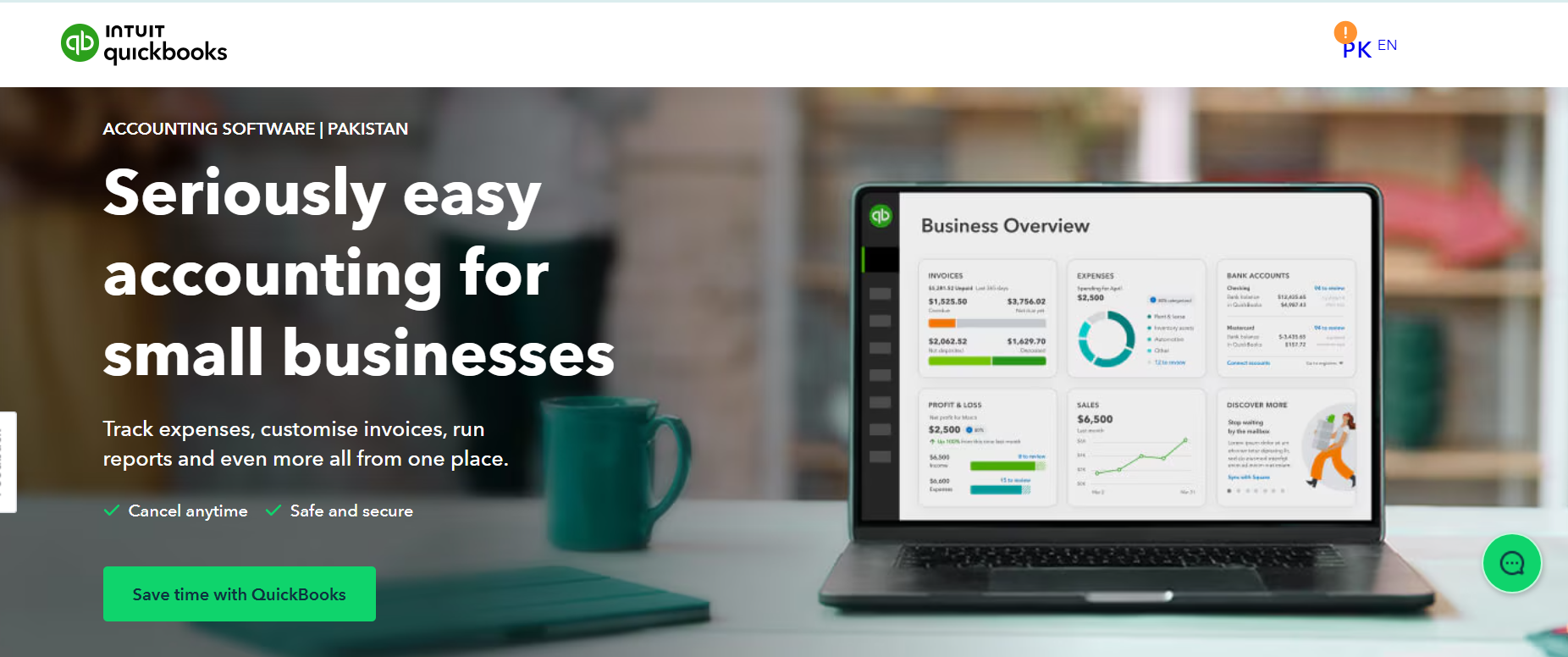
QuickBooks Online Landing Page Core strengths
- It reconciles daily transactions automatically.
- Custom reporting supports balance sheets, cash flow statements, and budgeting.
- App integrations include over 750 third-party tools and full API support.
- Operational efficiency, including permission controls and mobile access, suits growing teams.
Usage Experience
Customers report a quick onboarding process with robust support for migrating legacy data. The interface is intuitive, but advanced features like inventory or complex asset tracking may require add-ons or integrations.
-
Xero
Xero is a cloud-native accounting platform designed to give users comprehensive visibility into their finances.
With over 21,000 bank integrations, it auto-imports and reconciles transactions using smart rules and AI-based matching.
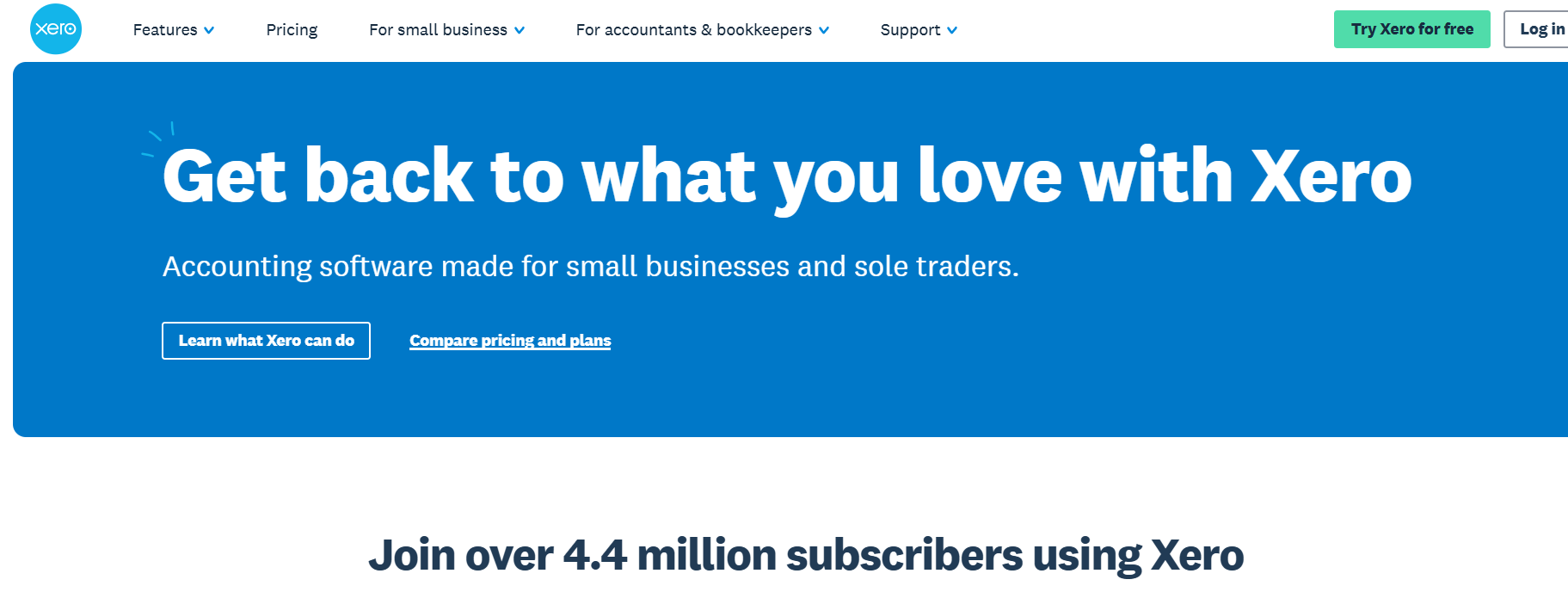
Xero Landing Page Its features include
- Real-time bank reconciliation with bulk actions and customizable rules.
- Create and send branded invoices online; integrate with Stripe, PayPal, and GoCardless.
- It includes receipt capture via mobile and the Inventory Plus add-on.
- Exportable reports, drilldowns, visualizations, and report packages for lenders or investors.
Usage Experience
While there’s a slight learning curve for deeper features, Xero scales elegantly from solopreneurs to established SMEs. It plays well with external apps, and its security and mobile accessibility make it a top pick.
-
FreshBooks
FreshBooks targets service-based businesses—freelancers, agencies, consultants—with an emphasis on simplicity and client-focused billing.
It combines invoicing, time/mileage tracking, expense logging, and lightweight accounting all in one.
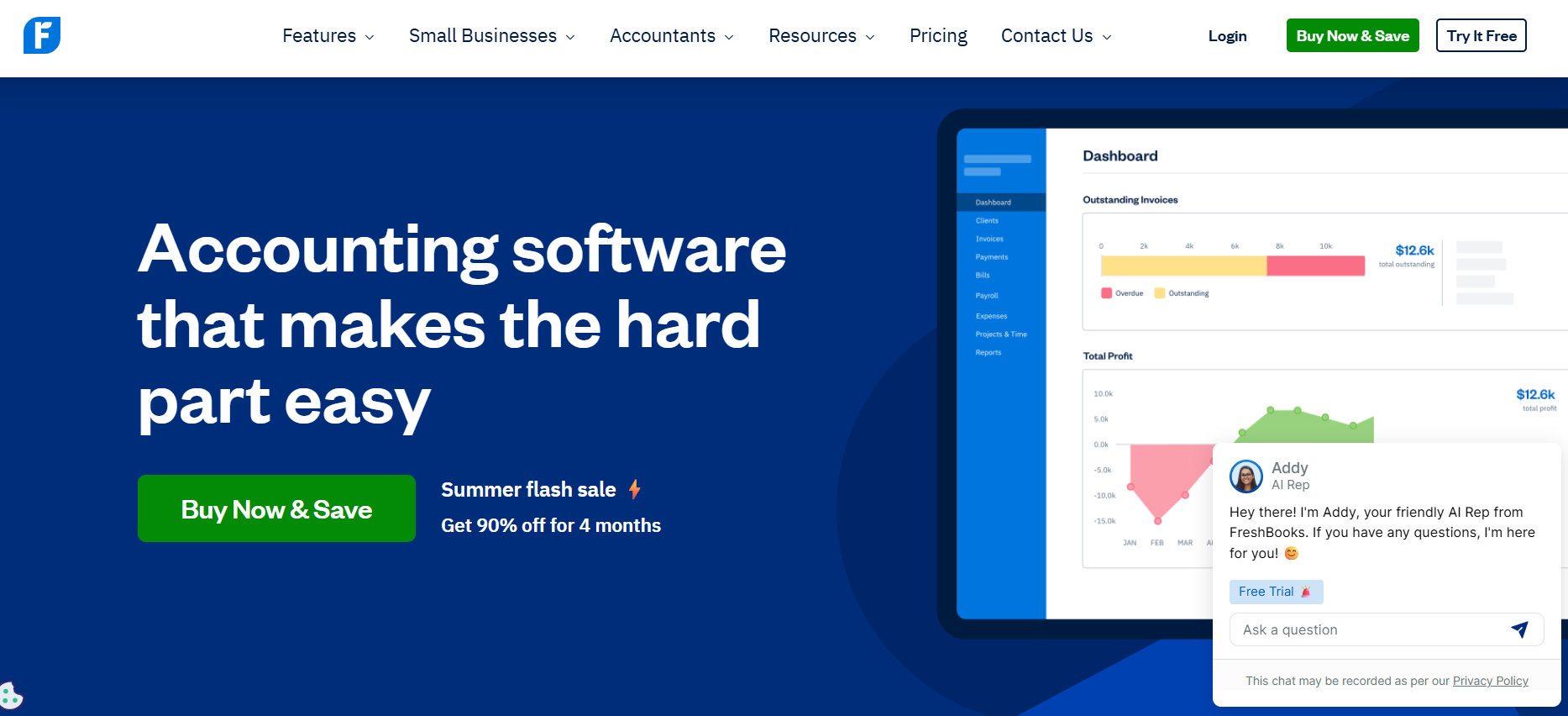
FreshBooks Landing Page Feature Highlights
- Brandable templates, recurring scheduling, automatic reminders, and instant payment via Stripe/PayPal/Square integration.
- Log billable hours and expenses via mobile app for seamless invoicing.
- Continuous syncing and reconciliation of bank and card accounts across tiers.
- Over 100 partner apps, including PayPal, Slack, and Trello.
Usage Experience
FreshBooks is lauded for its intuitive design, making it ideal for users without extensive accounting backgrounds.
-
Sage Intacct
Sage Intacct, though more enterprise-grade, delivers cloud-native, multi-entity accounting and advanced financial management suited for growing mid-market companies.
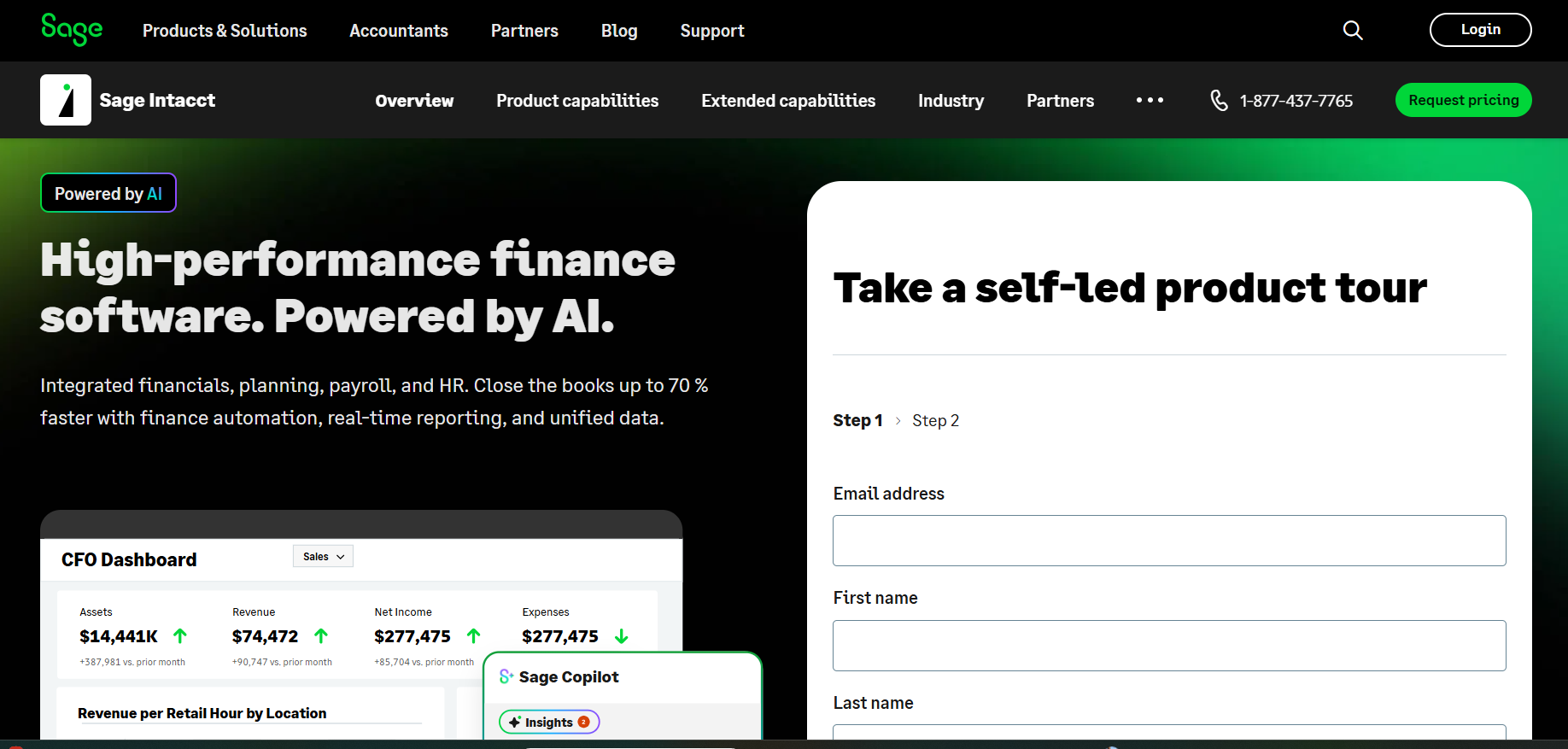
Sage Intacct Landing Page Core offerings
- Manage multiple entities, currencies, and countries under one roof.
- Real-time financial insights with customizable KPIs and drill-through analytics.
- Streamline AP/AR, order-to-cash, and record-to-report cycles.
- Seamless connectors to CRM, HRIS, and ERP systems provide comprehensive financial flows.
Usage Experience
Users cite its customizability and depth as transformative for financial clarity, though some report steeper learning curves and implementation timelines.
-
Zoho Books
Zoho Books is a compelling option for small and growing businesses seeking a complete, cost-effective cloud accounting solution.
Part of the Zoho One suite, it offers end-to-end finance management from invoicing to compliance.
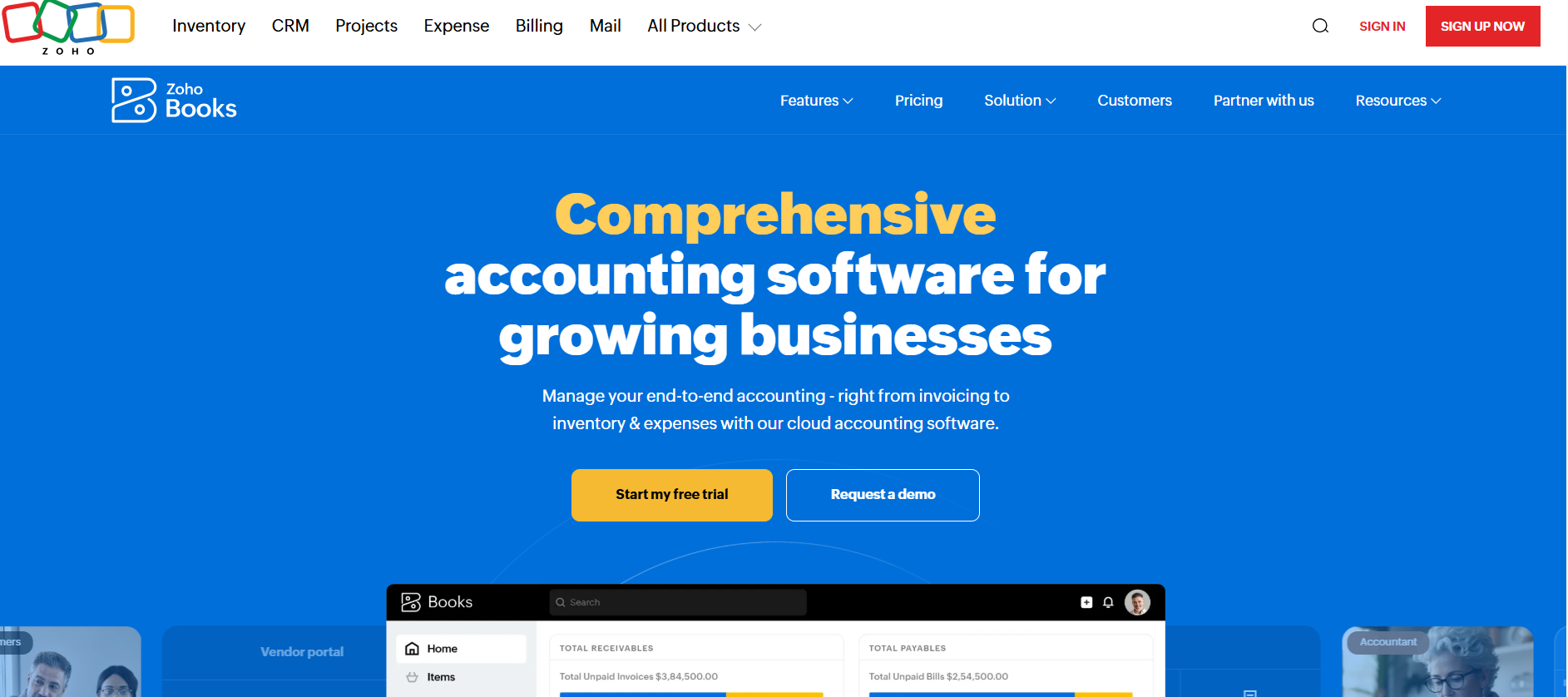
Zoho Books Landing Page Distinct strengths
- Invoicing, expenses, bank reconciliation, and double-entry bookkeeping.
- Tax management for VAT/GST systems in multiple countries.
- Workflow rules for invoice reminders, approvals, and reconciliation.
- Connects out-of-the-box with Zoho CRM, Projects, Inventory, and hundreds of third-party tools.
Usage Experience
Zoho Books balances usability with depth. Small teams appreciate the affordability, broad functionality, and automation.
Best SaaS Tools for Customer Support and Communication
Customer support in 2025 demands seamless, personalized, and efficient communication across email, chat, phone, social media, and even in-app messaging.
The best SaaS solutions not only centralize interactions but also empower teams with AI-driven automation, self-service portals, and analytics.
Here are five standout tools designed to elevate your support and engagement game.
-
Zendesk
Zendesk is a market leader in omnichannel customer support.
Its suite connects every interaction—email, chat, phone, messaging, and social—into one clean interface for agents, ensuring a smooth customer journey across touchpoints.
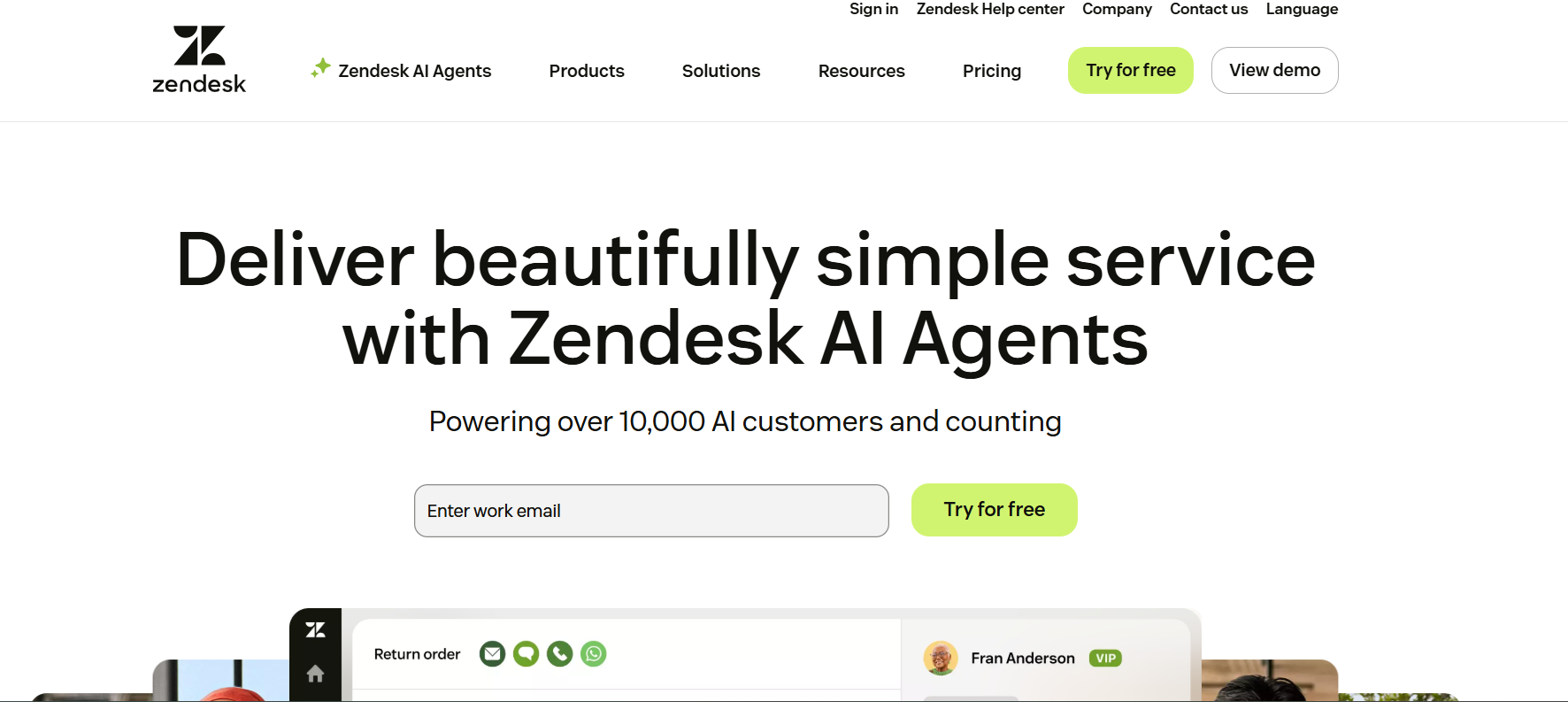
Zendesk Landing Page Key Features
- Unified Ticketing System: All conversations are converted into trackable tickets with full context.
- AI & Automation: Built-in bots assist with triaging, routing, and responding to repetitive queries.
- Multilingual Help Centers: Create searchable knowledge bases to reduce incoming requests.
- SLA Tracking & Advanced Reporting: Monitor agent performance, resolution times, and customer satisfaction with detailed metrics.
User Experience
Zendesk is known for its flexibility and scalability. The interface is polished and intuitive, suitable for large support teams managing complex, high-volume interactions.
-
Intercom
Intercom focuses on real-time, conversational customer engagement.
It’s ideal for SaaS businesses looking to blend live chat, bots, and email into a cohesive in-app experience.
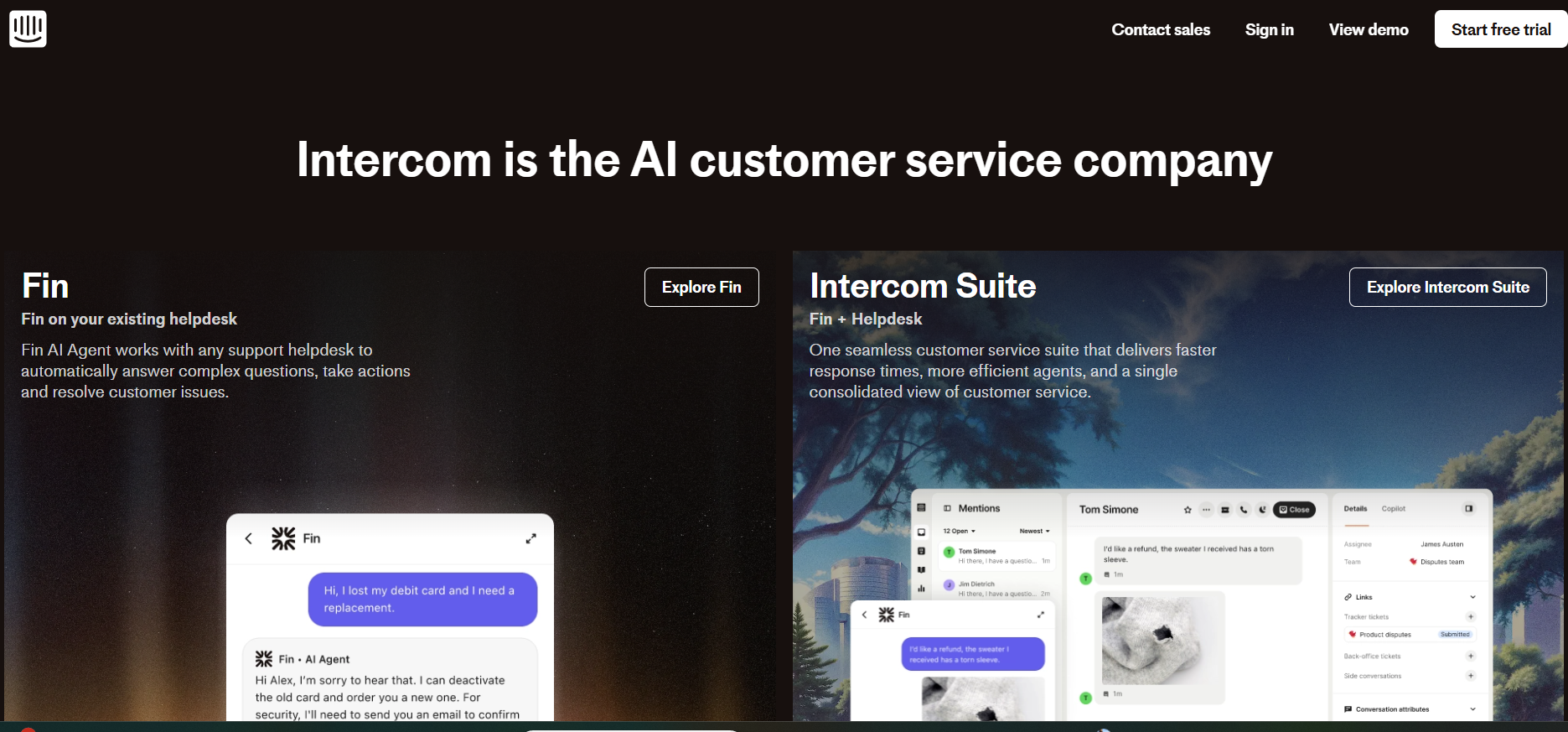
Intercom Landing Page Key Features
- Conversational Support: AI bots initiate chats, handle FAQs, and route tickets automatically.
- Behavior-Based Messaging: Trigger proactive messages based on user actions or status.
- Custom Bots and Workflows: Automate onboarding, lead qualification, and escalations.
- In-App Product Tours: Onboard new users with interactive guides and support triggers.
User Experience
Intercom offers a modern, minimalistic design that simplifies communication. It’s especially powerful in product-led environments where support is embedded directly into the app.
-
HelpCrunch
HelpCrunch is a multi-channel support platform combining live chat, email automation, and a knowledge base.
It’s tailored for startups and small teams that need responsive, budget-friendly tools.
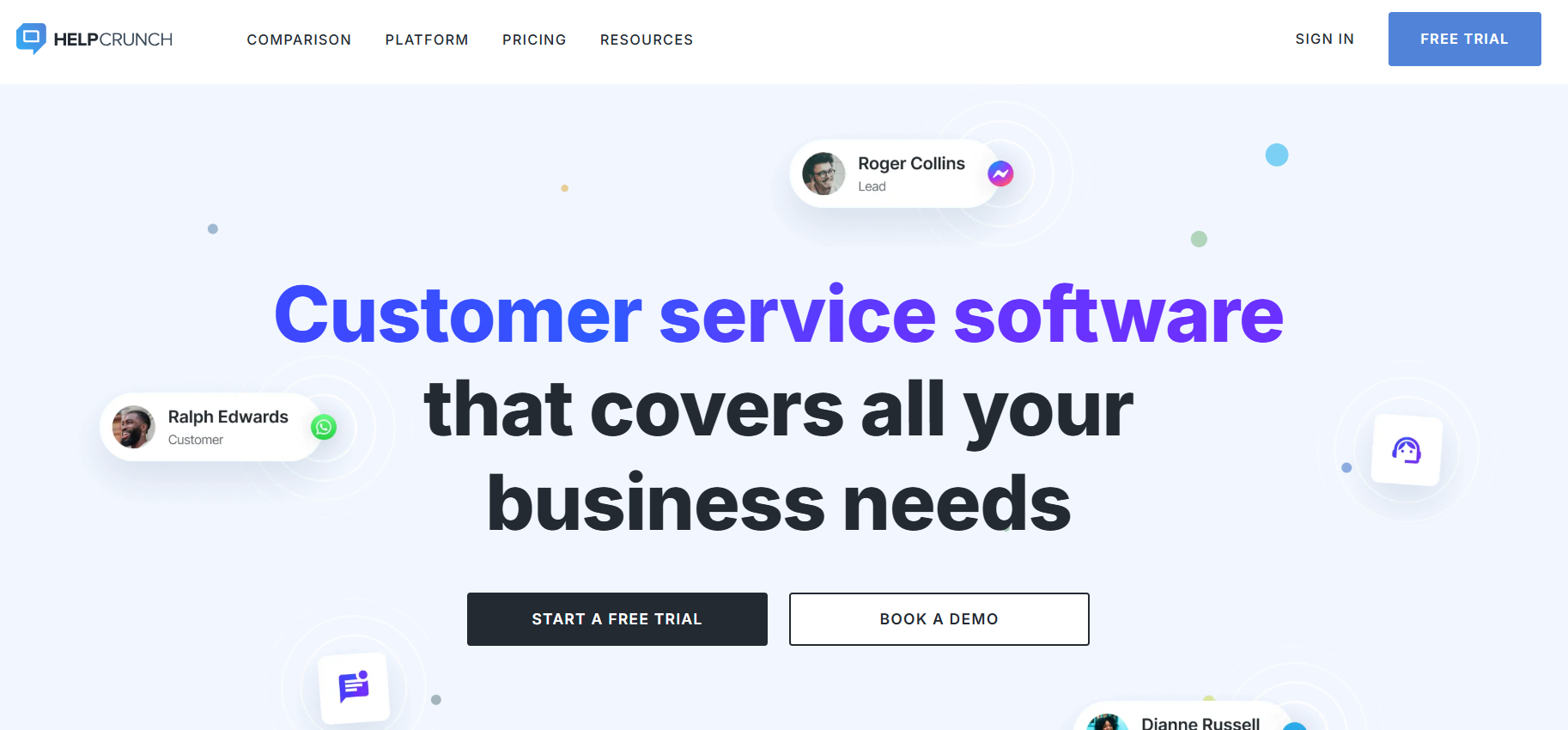
HelpCrunch Landing Page Key Features
- Real-Time Chat: Modern chat widget for websites and apps, with chat transcripts and agent routing.
- Email Campaigns: Send automated follow-ups, newsletters, or onboarding sequences.
- Shared Inbox: View, assign, and resolve customer conversations from one centralized workspace.
- Self-Service Hub: Build a lightweight knowledge base to empower users.
User Experience
HelpCrunch is often praised for how quickly it can be deployed and customized. Teams without dedicated IT support can get started with ease.
-
Freshdesk
Freshdesk offers robust help desk functionality with automation, collaboration tools, and omnichannel support.
It’s designed for scaling teams that want AI and automation without the enterprise price tag.
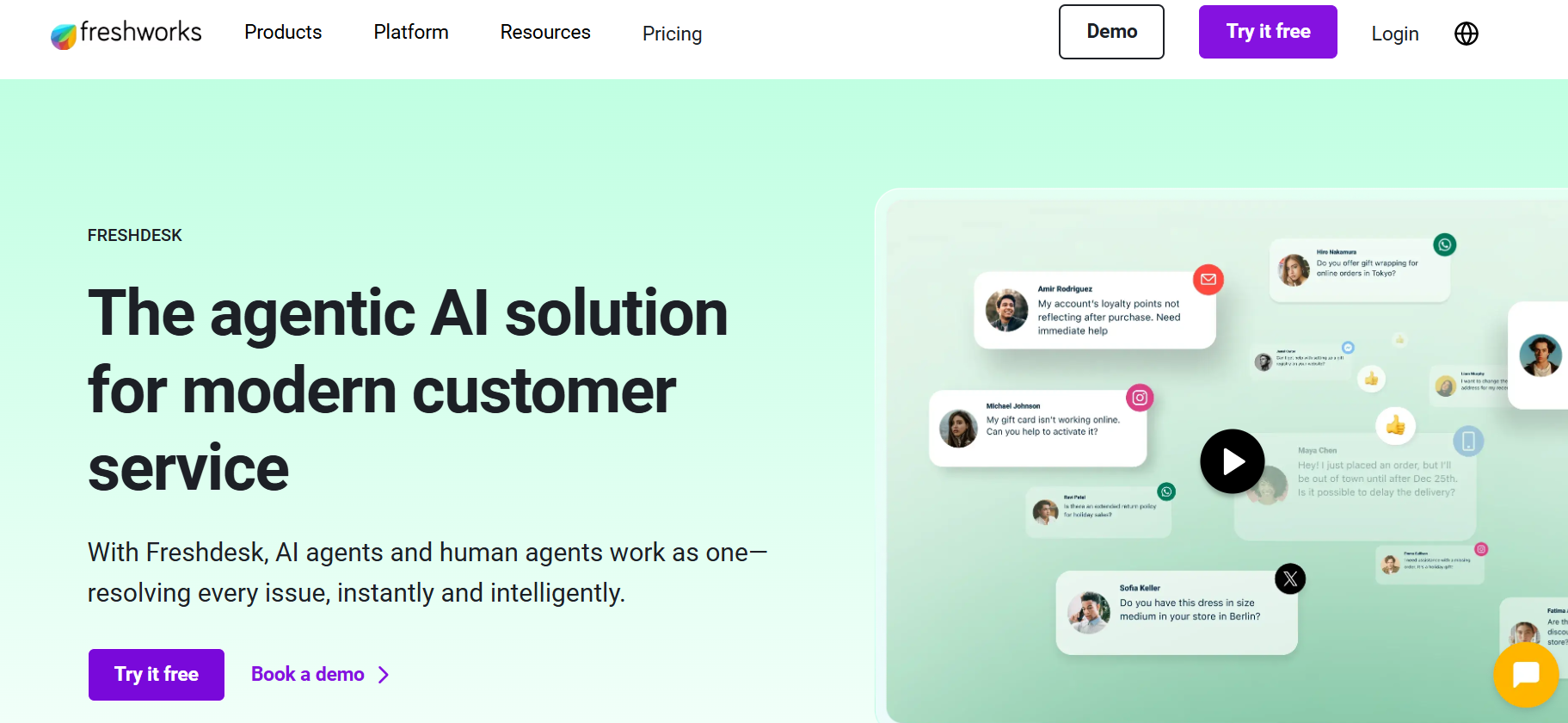
Freshdesk Landing Page Key Features
- AI-Powered Agent (Freddy): Automates common responses, predicts user intent, and assists with translations.
- Multi-Channel Ticketing: Manage email, phone, live chat, social media, and WhatsApp in one place.
- Collaboration Features: Use internal notes, ticket merging, and agent collision detection for smooth teamwork.
- Service Level Monitoring: Set SLAs and track compliance across agents and channels.
User Experience
Freshdesk combines simplicity with power. It’s intuitive enough for small teams but has enterprise-grade features for larger operations.
-
Zoho Desk
Zoho Desk is part of the larger Zoho ecosystem, making it an ideal choice for teams already using Zoho CRM, Projects, or Books. It’s known for its deep integrations and comprehensive automation.

Zoho Desk Landing Page Key Features
- Context-Aware Support: Get customer details, prior interactions, and CRM notes in every ticket.
- AI Assistant (Zia): Predicts ticket sentiment, suggests responses, and flags anomalies.
- Multi-Channel Help Desk: Centralizes email, chat, phone, social, and community interactions.
- Automation Rules: Build workflows for ticket assignments, approvals, escalations, and alerts.
User Experience
Zoho Desk is particularly strong when used within the Zoho Suite, offering seamless workflows across departments. It’s flexible and affordable, with rich automation and reporting tools.
CTA: Struggling to Write Captions? Let AI Do It.
Use Social Champ’s AI-powered caption generator to craft platform-optimized content instantly, tailored for tone, audience, and hashtags.
Top SaaS Tools for Project Management and Team Collaboration
The right SaaS tools for project management and collaboration can eliminate silos, reduce missed deadlines, and enhance team productivity—whether you’re co-located or fully remote.
Below are five standout tools that lead the market in functionality, adaptability, and team experience.
-
Asana
Asana is a work management platform designed to help teams organize, track, and manage their work.
Its flexible structure allows users to plan anything, from strategic goals to daily to-dos.
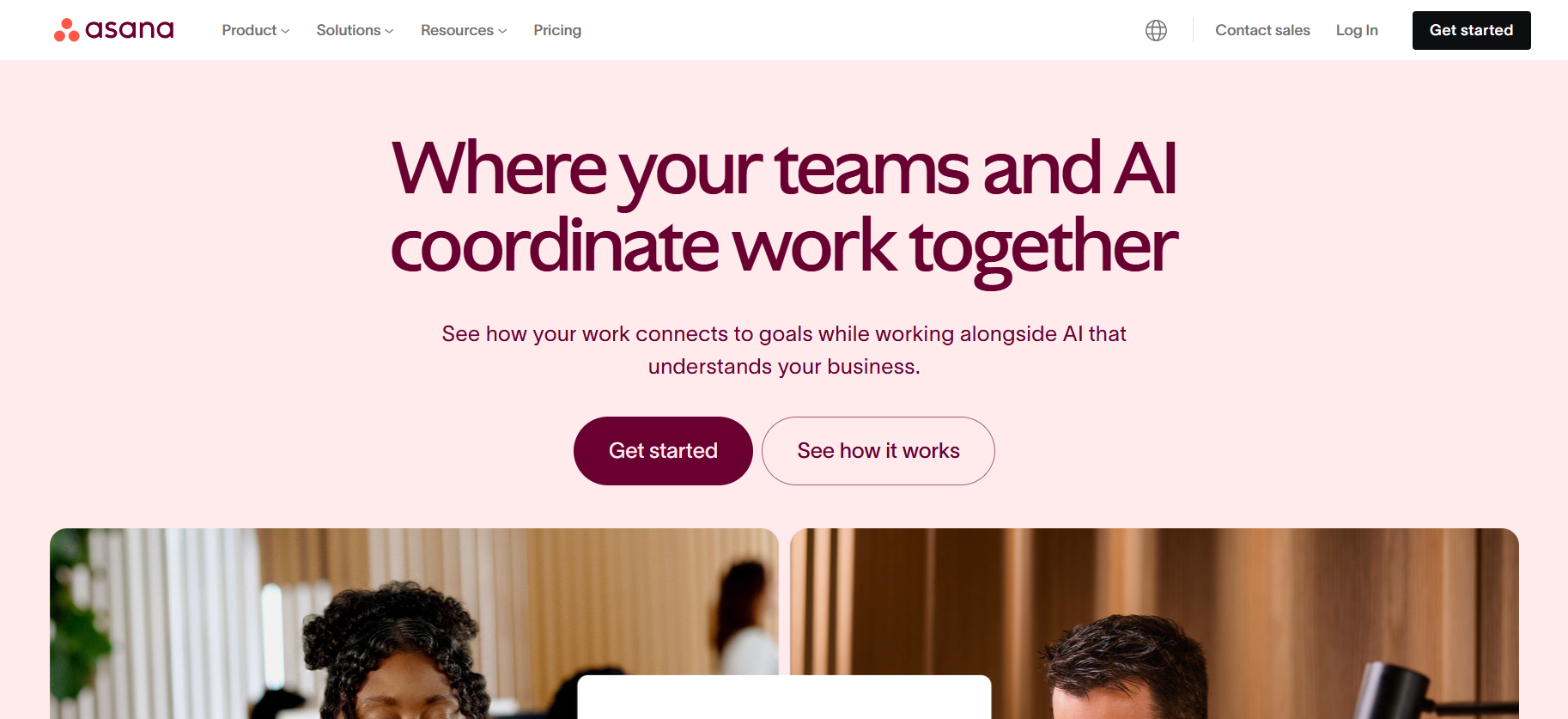
Asana Landing Page Key Features
- Multiple project views: List, Board, Calendar, Timeline (Gantt-style), and Dashboards.
- Automation rules to streamline workflow, Such as assigning tasks, changing statuses, or sending alerts.
- Built-in Goals feature: To align team efforts with high-level objectives.
- Reporting: Advanced reporting with real-time dashboards and workload tracking.
User Experience
Teams often praise Asana for its clean interface and powerful automation. It’s intuitive for newcomers but scalable enough for enterprise workflows.
-
Trello
Trello is a visually intuitive Kanban-based tool ideal for task tracking, content planning, and light project coordination.
Its board-and-card system is especially popular for managing simple workflows.
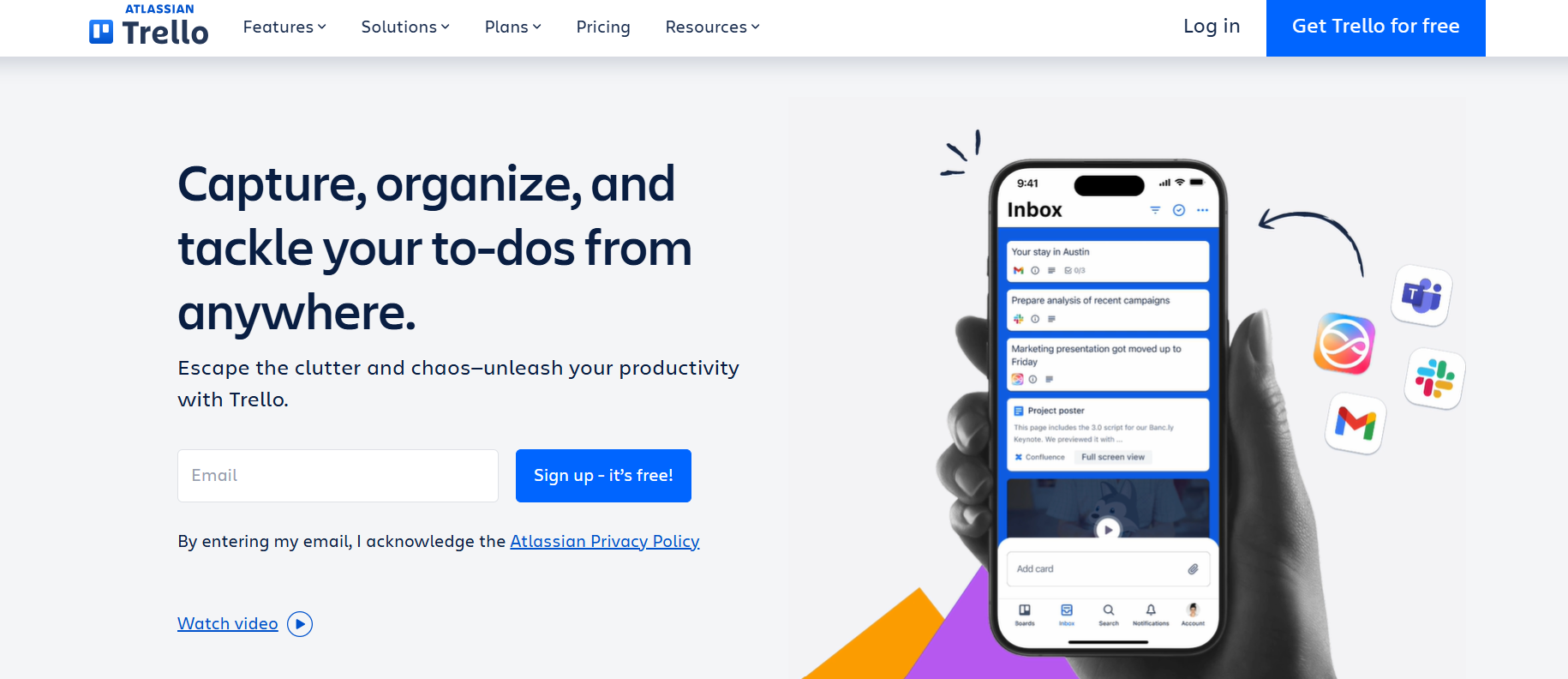
Trello Landing Page Key Features
- Drag-and-drop boards with customizable columns and task cards.
- Built-in automation with Butler to trigger reminders, assign tasks, or move cards.
- Various view modes like Calendar, Dashboard, Table, and Timeline.
- Power-Ups (integrations) for Slack, Google Drive, Jira, and more.
User Experience
Trello is known for its minimal learning curve and fast onboarding. It’s a favorite among content teams, educators, and marketers due to its visual simplicity.
-
ClickUp
ClickUp offers an all-in-one project and productivity platform that consolidates task management, documentation, goal setting, and time tracking in one interface.
It’s one of the most comprehensive project management tools available.

ClickUp Landing Page Key Features
- Highly customizable views: List, Kanban, Calendar, Gantt, Mind Map, and Whiteboards.
- Advanced automation capabilities across tasks, statuses, notifications, and assignments.
- Built-in Docs, Chat, and Goals modules to centralize all team activity.
- Time tracking with timesheets, workload dashboards, and global reporting.
- AI capabilities like auto-summaries, task suggestions, and auto-filling fields.
User Experience
ClickUp is a go-to for high-performing teams that need everything in one place. While it has a steeper learning curve due to its expansive features, its flexibility pays off for teams managing multiple workflows.
-
Monday.com
Monday.com is a highly visual platform that helps teams manage work through customizable boards, dashboards, and automation.
It’s suitable for anything from software development to marketing and HR operations.
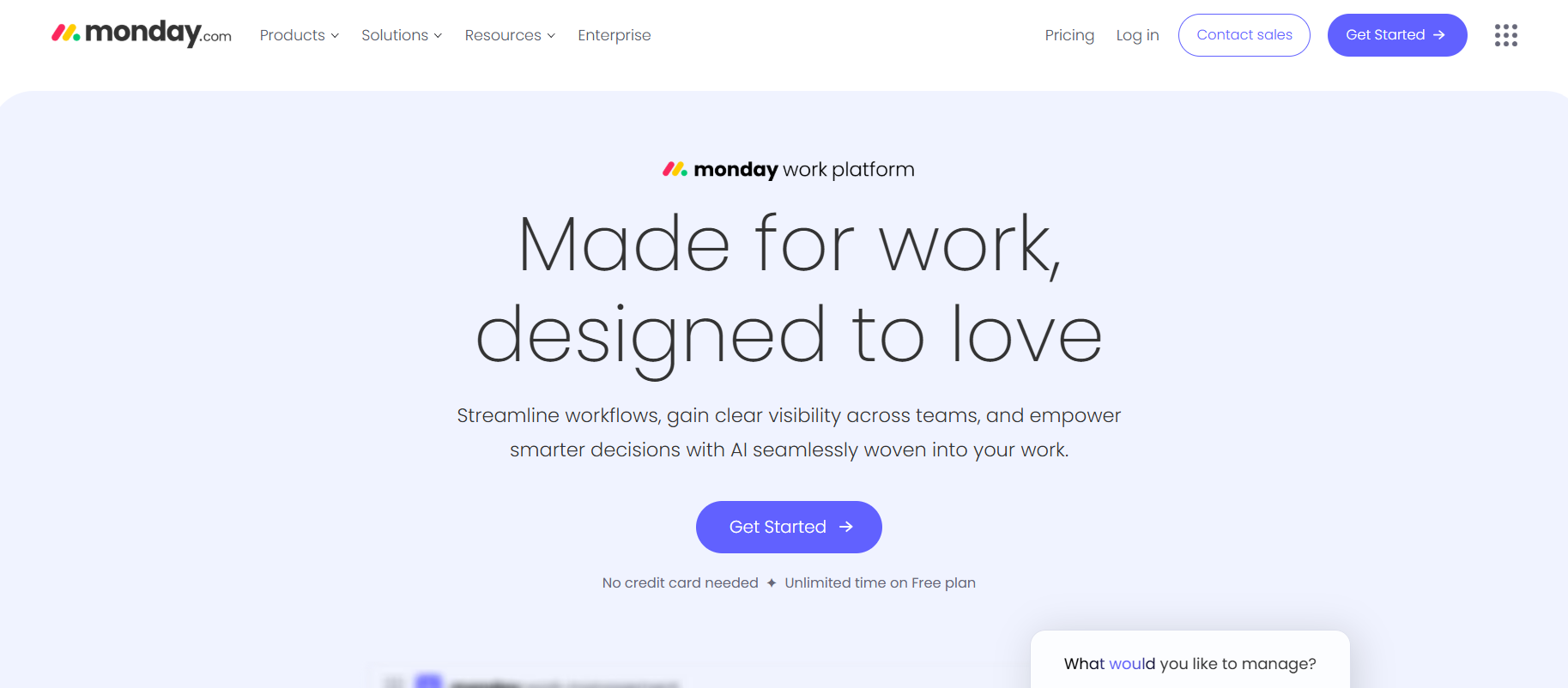
Monday.com Landing Page Key Features
- Customizable boards with columns for statuses, timelines, priorities, and text.
- Workload views, dashboards, and reports to monitor team performance and resource allocation.
- Rule-based automations to handle repetitive tasks like notifications and status updates.
- Integration with tools like Microsoft Teams, Dropbox, Outlook, and over 100 others.
User Experience
Monday.com strikes a balance between structure and flexibility. Its strong visual appeal, ease of use, and versatility make it popular among both technical and non-technical teams.
-
Notion
Notion is a hybrid platform combining documentation, task management, databases, and internal wikis into a single workspace.
It’s ideal for teams that want to manage projects and content collaboratively in one ecosystem.
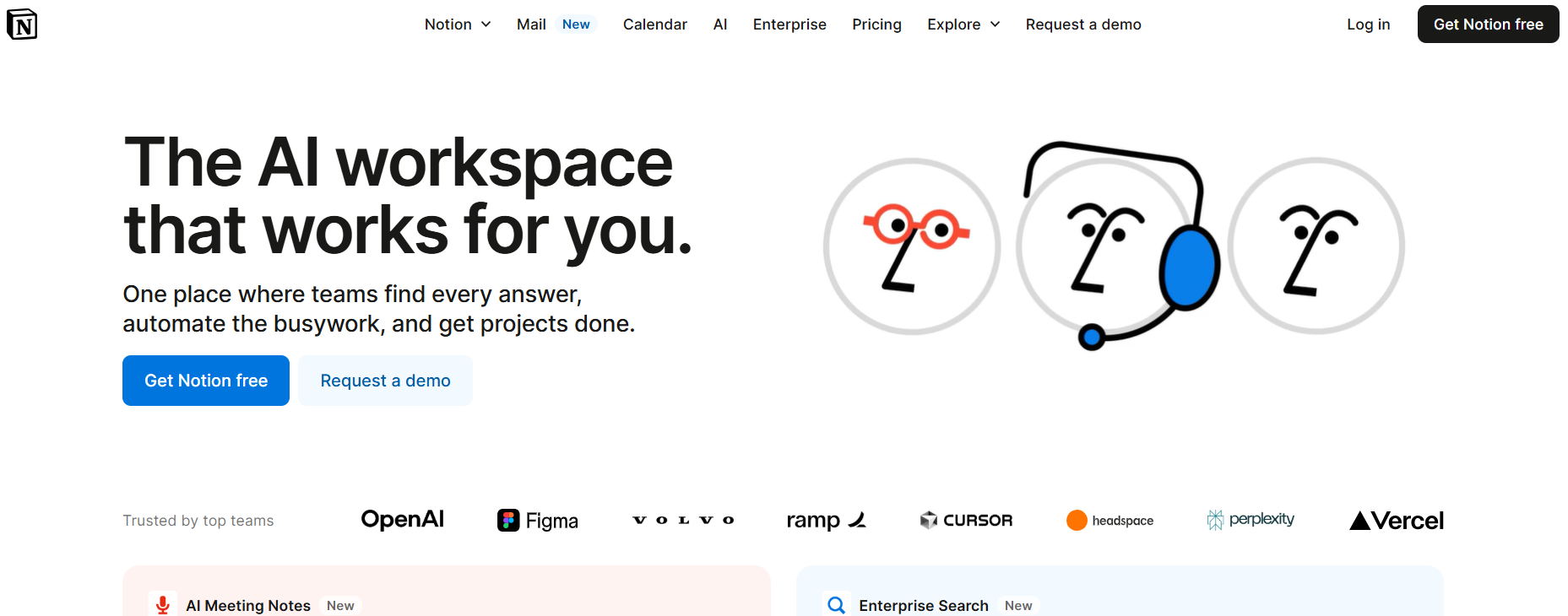
Notion Landing Page Key Features
- Block-based page builder supporting text, databases, checklists, and media.
- Relational databases that can power CRMs, content calendars, or sprint trackers.
- Templates for workflows like roadmaps, meeting notes, OKRs, and product specs.
- Real-time collaboration, comments, and mentions for efficient teamwork.
User Experience
Notion is praised for its adaptability. Whether you’re running a product roadmap, building a knowledge base, or managing tasks, it allows complete freedom in structuring content.
Featured Article: Twitter Algorithm 2025: How It Works & How to Beat It
Recommended SaaS Tools for Data Analytics and Business Intelligence
SaaS tools for data analytics and business intelligence help businesses visualize, understand, and act on data faster and more accurately—whether it’s sales trends, customer behavior, or operational performance.
Here are a few standout tools that are transforming how modern businesses handle data.
-
Tableau
Tableau is a market leader in the BI space, known for its powerful data visualization capabilities.
It enables users to build interactive dashboards, reports, and maps using real-time or historical data from virtually any source.
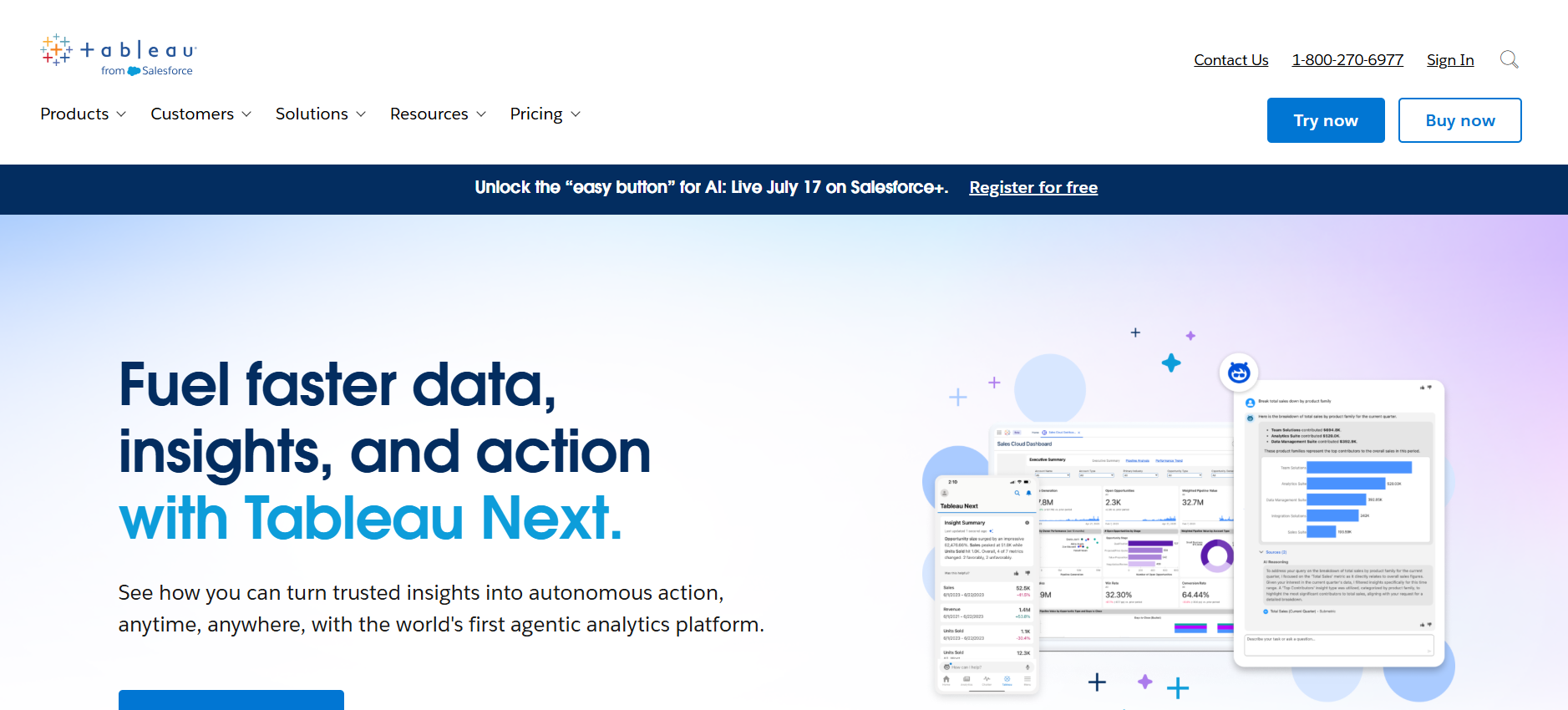
Tableau Landing Page Key Features
- Drag-and-drop interface for fast and easy dashboard creation
- Connects with hundreds of data sources, including SQL, spreadsheets, cloud apps, and big data platforms
- Real-time data updates and auto-refresh for live monitoring
- Advanced visualizations including heat maps, scatter plots, and geographic data mapping
User Experience
Tableau’s interface makes complex data accessible even for non-technical users. It’s widely appreciated for its speed and flexibility in dashboard design, while more technical users leverage its calculated fields and advanced filters.
-
Looker
Looker, now part of the Google Cloud Platform, offers a modern approach to business intelligence by focusing on data modeling and governance.
It’s ideal for teams that prioritize consistency in metrics across the organization.
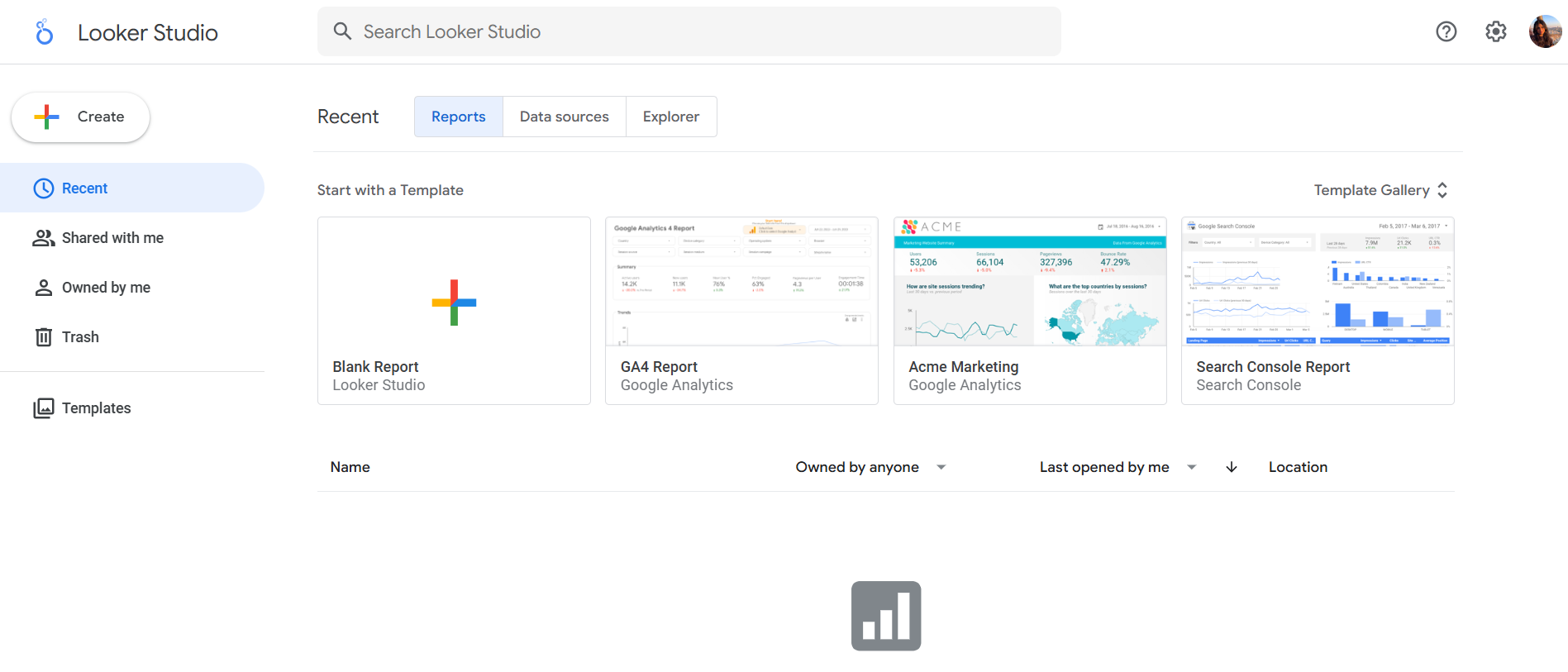
Looker Dashboard Key Features
- LookML modeling layer for centralized metric definitions
- Real-time data exploration directly on top of cloud warehouses like BigQuery and Snowflake
- Customizable dashboards and ad-hoc reporting
- Embedded analytics for client-facing portals and SaaS apps
User Experience
Looker appeals to companies that value clean, governed data access. Its modeling layer prevents conflicting KPIs by ensuring every department pulls from the same definitions.
-
Power BI
Microsoft Power BI is a robust analytics tool that combines data transformation, visualization, and AI-powered insights.
It’s deeply integrated into the Microsoft ecosystem, making it a natural fit for organizations already using Office 365, Azure, or Excel.

Power BI Landing Page Key Features
- Powerful data modeling with DAX and Power Query
- Interactive dashboards with real-time drill-down and filtering
- AI-assisted insights and natural language Q&A for intuitive exploration
- Seamless integration with Excel, Teams, SharePoint, and Dynamics 365
User Experience
Power BI is favored by analysts and business users alike for its flexibility and accessibility. Excel users especially find it easy to adopt due to its familiar formula logic.
-
SAS Viya
SAS Viya is a cloud-native platform combining advanced analytics, AI, and machine learning with business intelligence capabilities.
It’s designed for data-driven enterprises that need both precision and compliance in their analytics workflows.
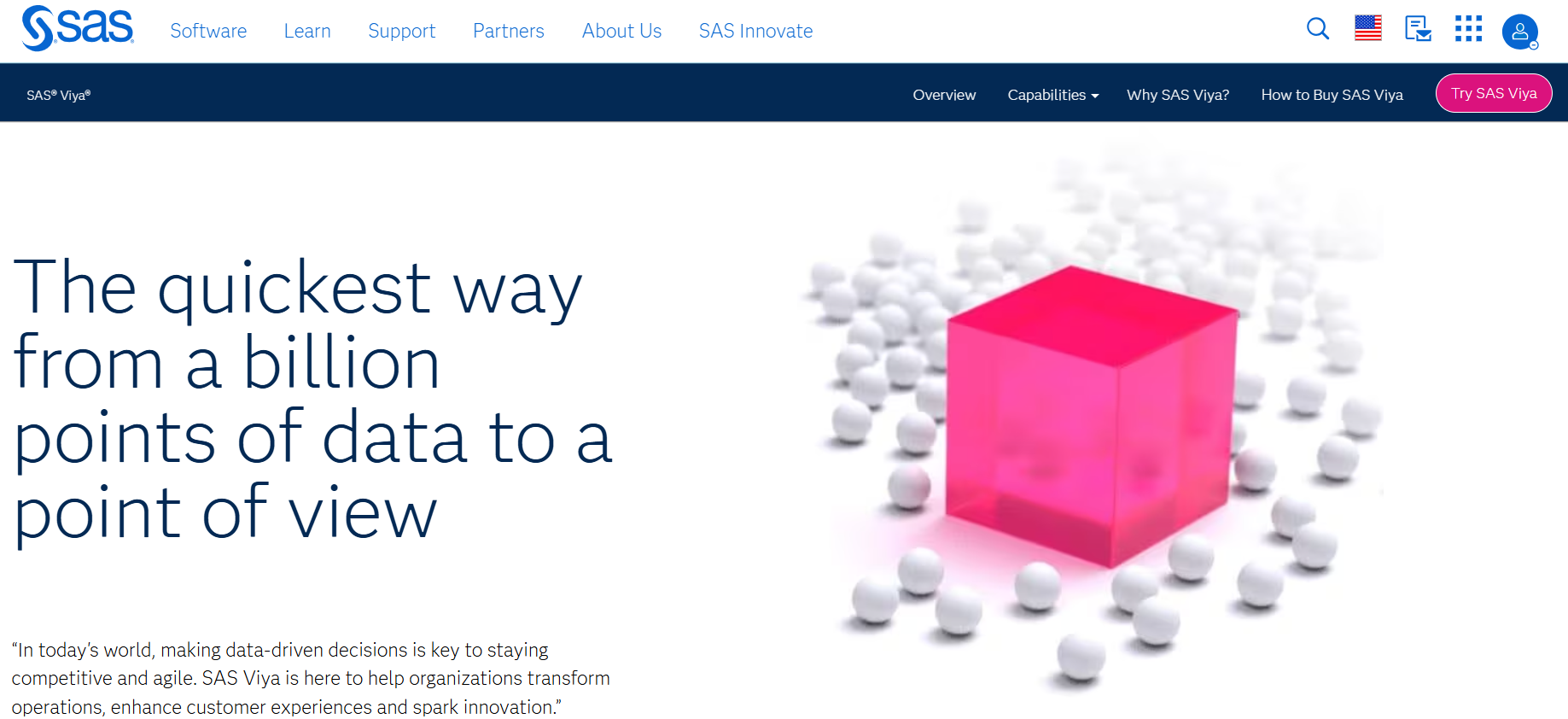
SAS Viya Landing Page Key Features
- End-to-end support for data preparation, modeling, and deployment
- Drag-and-drop tools for building predictive models
- Support for Python, R, and open-source integration
- AI model governance, bias detection, and auditability
User Experience
SAS Viya is built for power users and analysts working in regulated industries like healthcare, finance, or government. It supports everything from basic reporting to deep predictive modeling with strict compliance requirements.
-
Plausible Analytics
Plausible is a lightweight, privacy-focused analytics tool designed as an alternative to traditional web tracking solutions.
It’s ideal for teams that want clear metrics without invasive data collection practices.
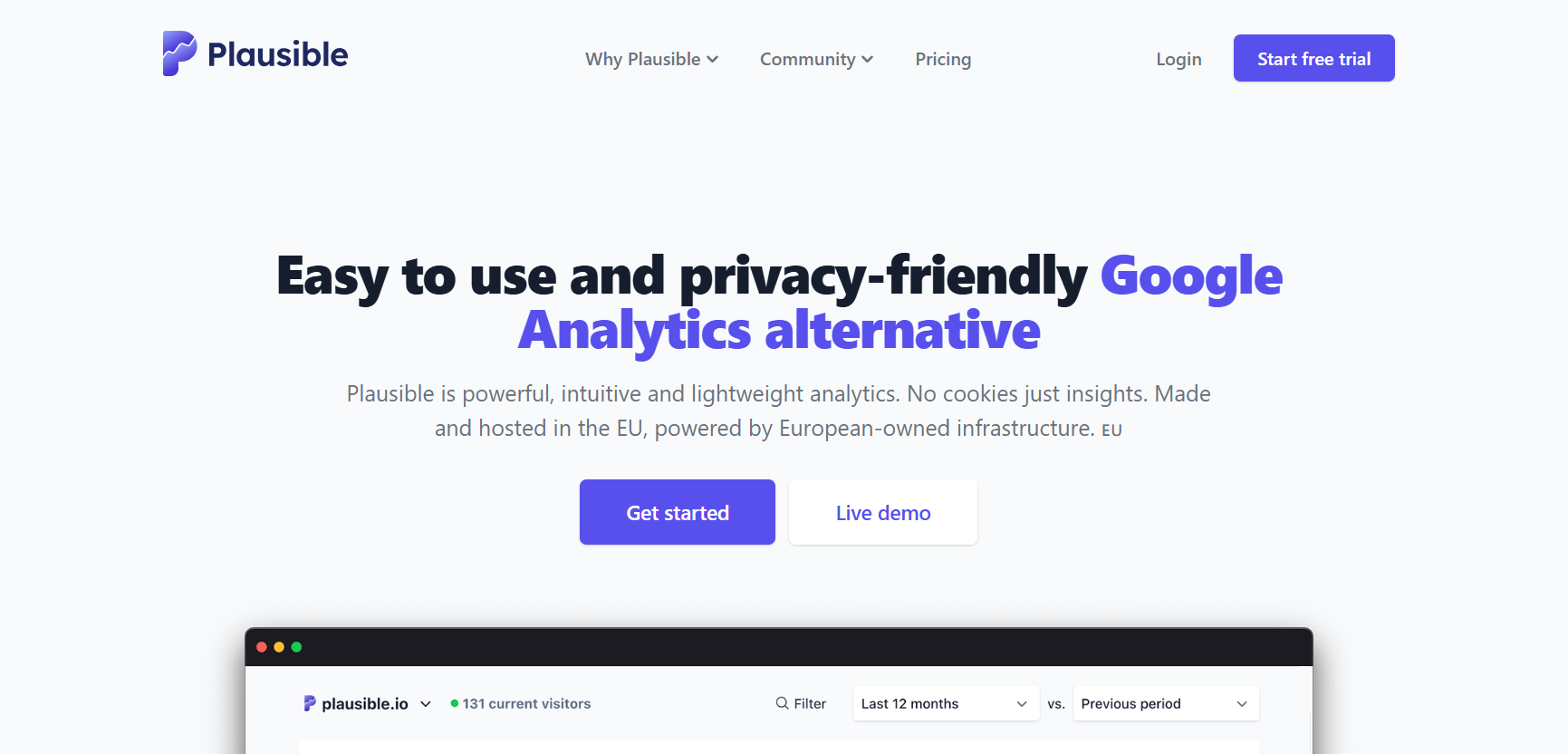
Plausible Analytics Key Features
- Simple dashboard showing real-time visitors, bounce rates, and goal completions
- Fast-loading, script-light implementation
- UTM tracking and event goals
- Shareable dashboards for public-facing transparency
User Experience
Plausible is loved for its clarity and simplicity. It eliminates the clutter of traditional analytics platforms, focusing on the core metrics that matter, without compromising user privacy.
Must-Have SaaS Tools for Human Resources and Employee Engagement
SaaS tools play a critical role in streamlining HR tasks while also enhancing employee experiences, from onboarding to performance tracking, payroll, and engagement.
The right platforms empower HR teams to focus on people, not paperwork.
Here are five top SaaS tools that are making a real impact in modern HR operations and employee engagement.
-
BambooHR
BambooHR is a user-friendly HR management system designed specifically for small to mid-sized businesses.
It focuses on making HR tasks smoother while creating a more personalized employee experience.
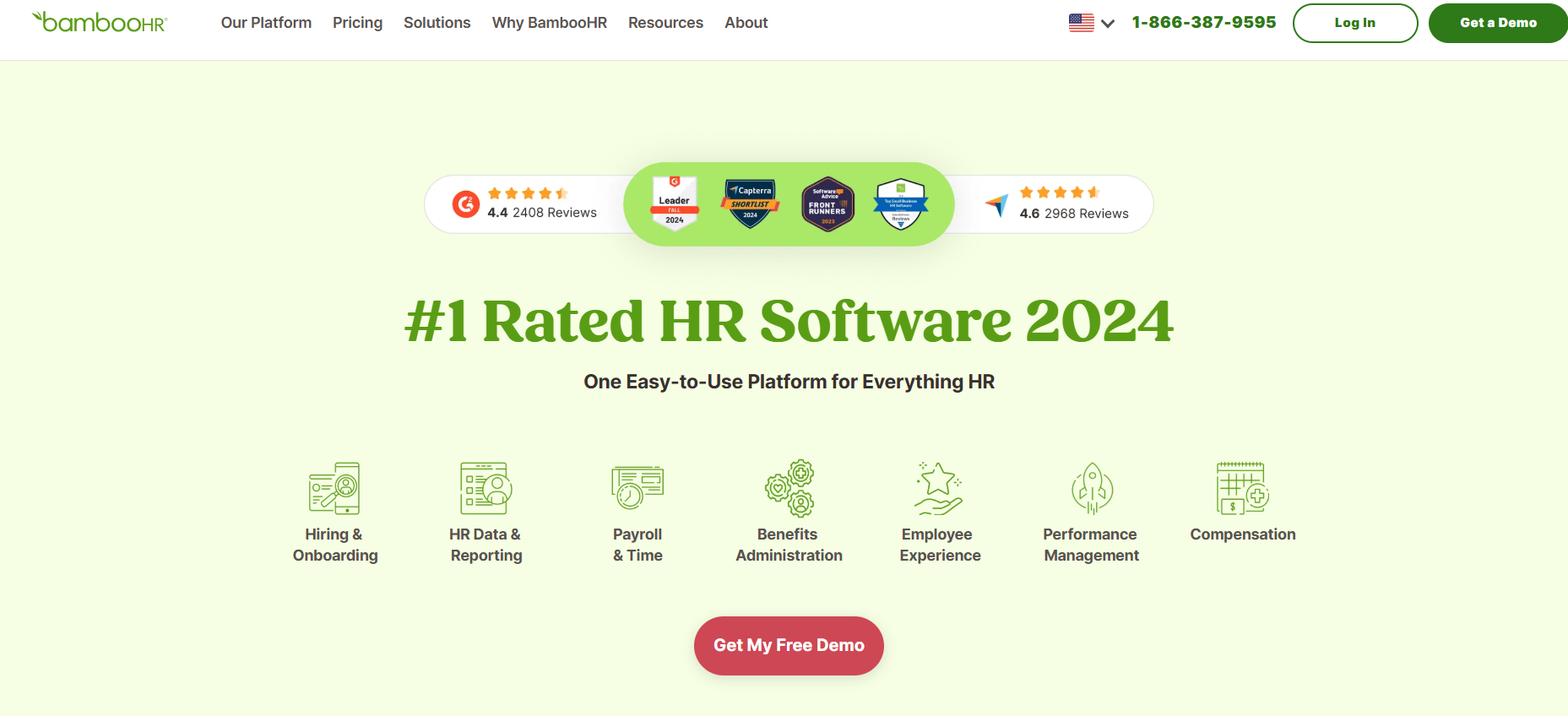
BambooHR Landing Page Key Features
- Centralized employee database with self-service portal
- Time-off tracking, approval workflows, and performance management
- Onboarding tools with customizable checklists and e-signatures
- Built-in reporting for headcount, turnover, PTO, and more
User Experience
BambooHR is often praised for its clean interface and ease of use. HR teams find it intuitive to set up, while employees appreciate the self-service access to their information, leave balances, and performance reviews.
-
Gusto
Gusto is a full-service platform that combines payroll, benefits administration, and HR management in a single, accessible tool.
It’s tailored for small businesses seeking to manage compensation and compliance seamlessly.
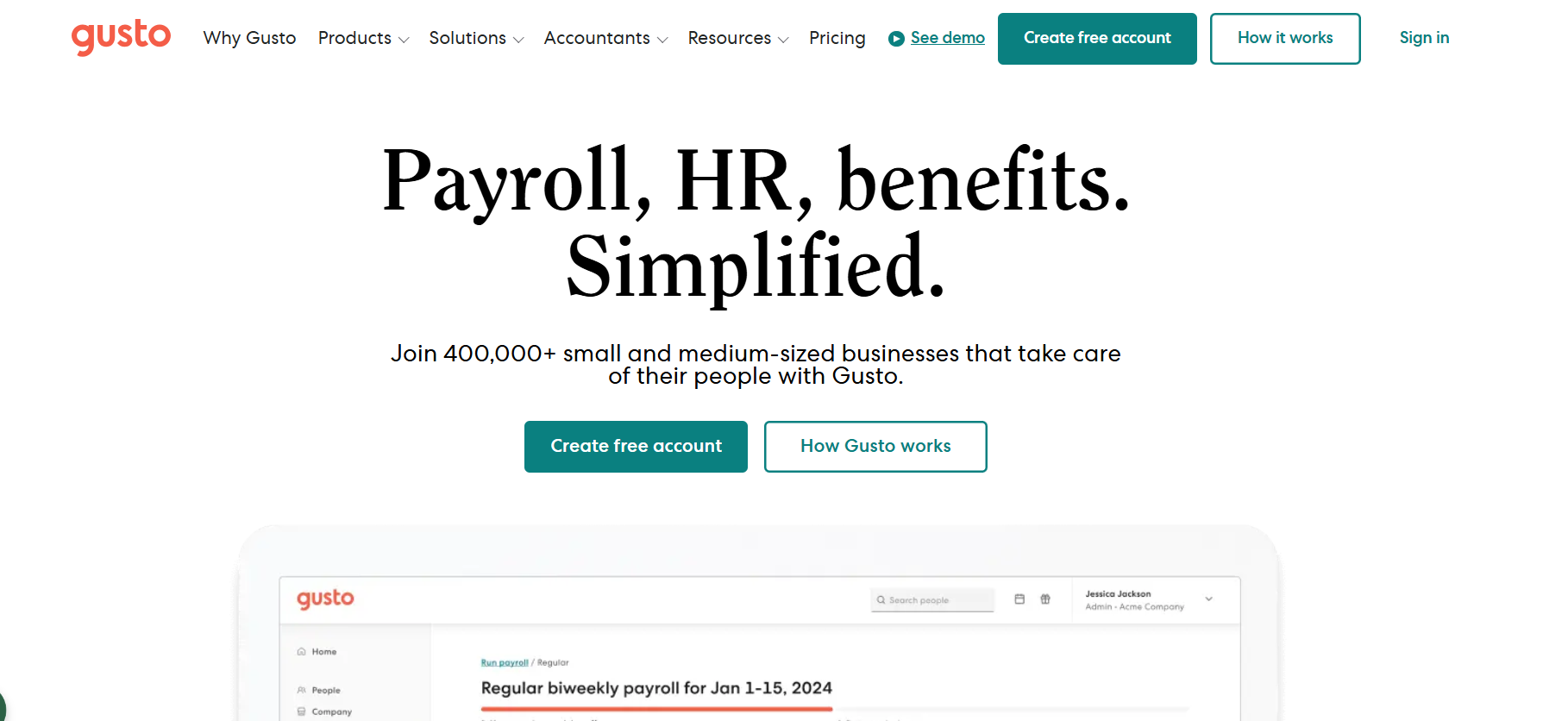
Gusto Landing Page Key Features
- Automated payroll with tax filing, direct deposits, and W-2 generation
- Employee benefits management, including health, retirement, and commuter plans
- Time tracking, PTO management, and employee onboarding
- Compliance alerts and document storage
User Experience
Gusto is renowned for turning payroll from a headache into a two-click process. Small business owners love its transparency, affordability, and automation.
-
Workday
Workday is an enterprise-level platform that integrates human capital management (HCM), payroll, and finance.
It’s built for large organizations that require deep workforce planning, compliance, and performance optimization.
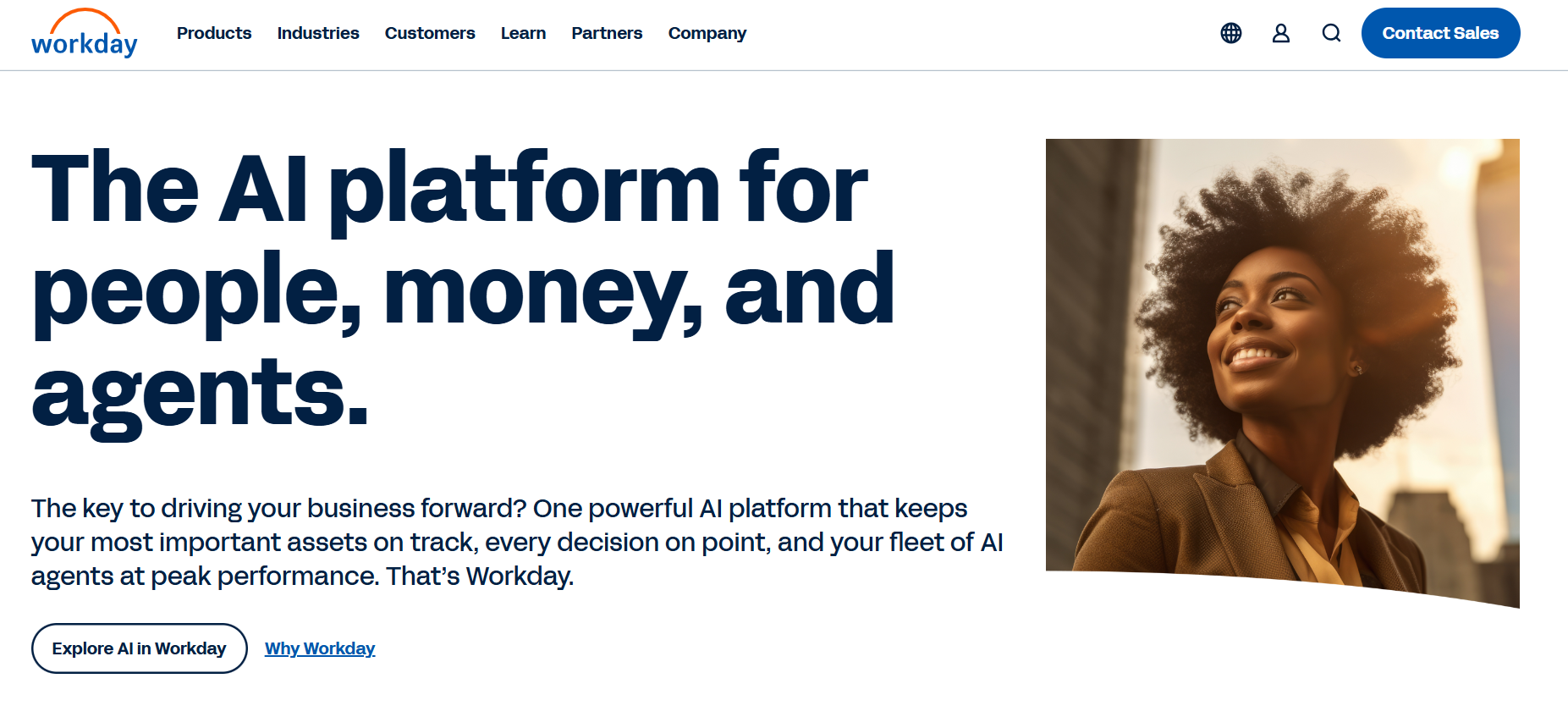
Workday Landing Page Key Features
- Unified HCM suite covering recruiting, onboarding, compensation, and talent management
- AI-powered insights for workforce planning and diversity tracking
- Mobile-first employee experience with role-based dashboards
- Goal alignment, feedback loops, and performance review workflows
User Experience
Workday is favored by global enterprises for its powerful reporting, compliance management, and cross-functional capabilities. While it has a steeper learning curve than smaller platforms, its real strength lies in its configurability and depth.
-
15Five
15Five is an employee engagement and performance management platform that enables managers to connect more meaningfully with their teams.
It emphasizes continuous feedback, recognition, and personal development.
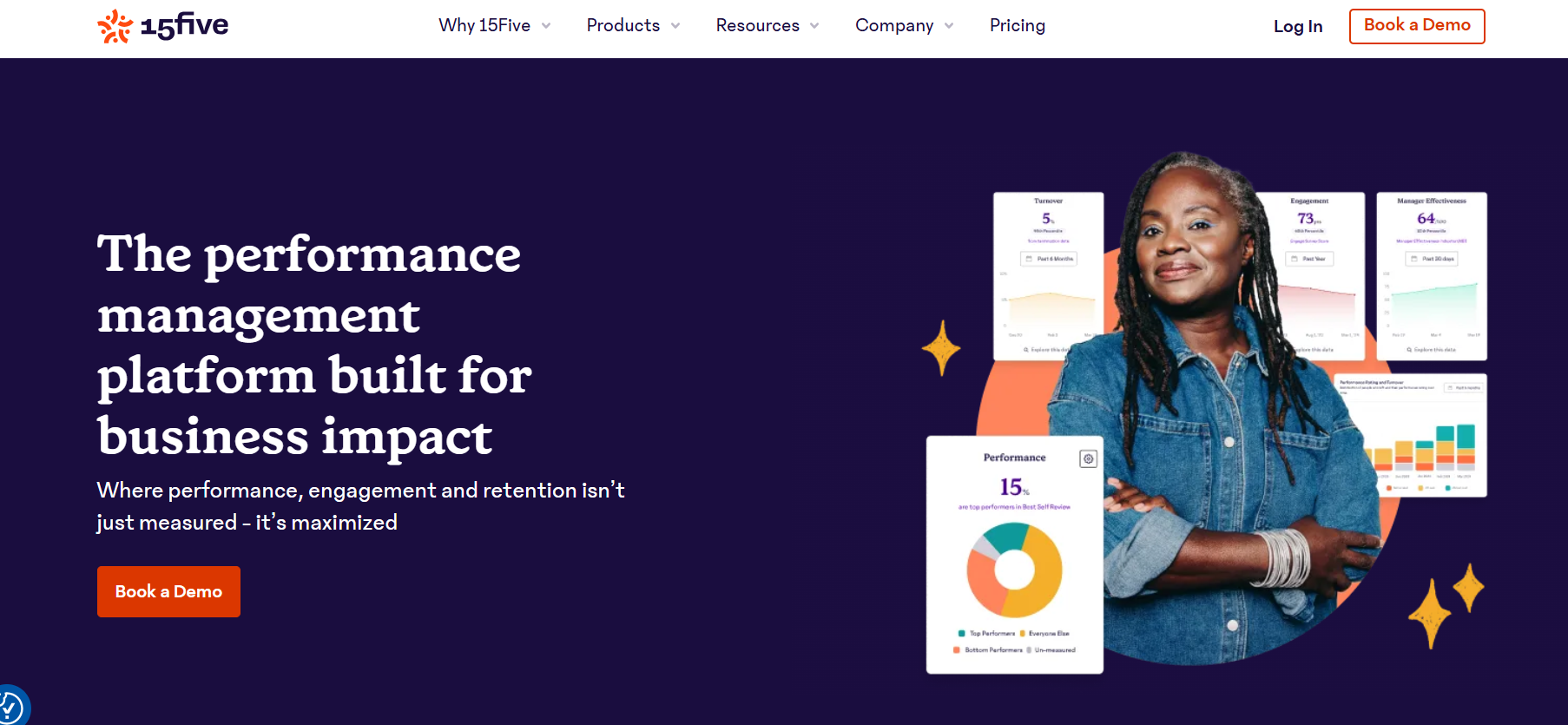
15Five Landing Page Key Features
- Weekly check-ins and pulse surveys for real-time feedback
- OKR tracking and alignment with organizational goals
- Performance review templates and calibration tools
- Peer recognition system (“High Fives”) to boost morale
User Experience
15Five is widely used by teams that prioritize culture and communication. It helps companies move beyond annual reviews to more agile, ongoing performance conversations.
-
Leapsome
Leapsome is a modular people enablement platform that merges performance reviews, learning, and employee engagement into one cohesive system.
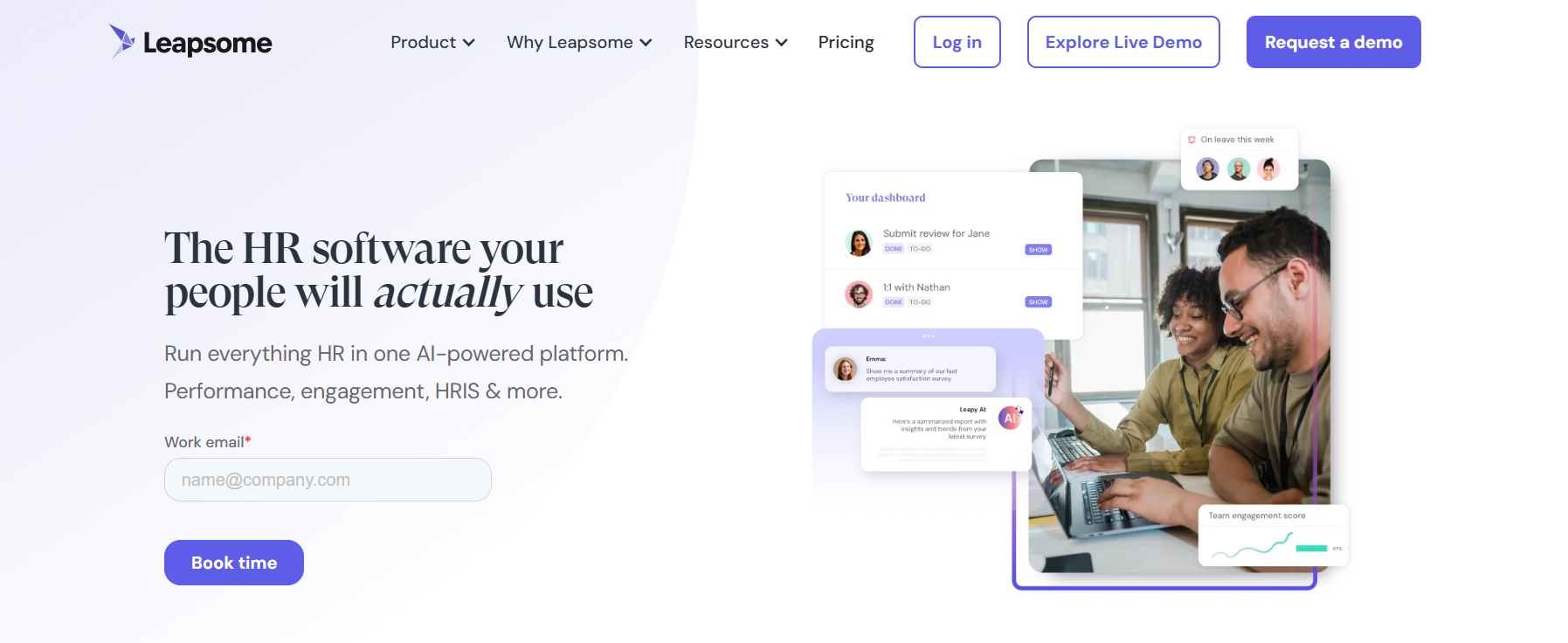
Leapsome Landing Page Key Features
- Structured performance reviews and 360-degree feedback
- Engagement surveys with sentiment analysis
- Learning paths and competency development
- Meeting management with an agenda and follow-up tracking
User Experience
Leapsome stands out for uniting performance management with employee development. Teams appreciate its modular nature—you can start with engagement surveys and add other features as needed.
Top SaaS Tools for Document Management and Collaboration
These platforms ensure content stays organized, accessible, and up to date, whether your team is working from a single office or across time zones.
Below are five standout tools leading the charge in document management and collaborative productivity.
-
Google Workspace
Google Workspace (formerly G Suite) is a cloud-based productivity suite combining tools like Google Docs, Sheets, Slides, Drive, and Meet into one integrated platform.

Google Workspace Landing Page Key Features
- Real-time co-editing across Docs, Sheets, and Slides
- Cloud-based storage via Google Drive with smart search
- Granular permission settings and link sharing
- Seamless integrations with Gmail, Calendar, and third-party apps
User Experience
Google Workspace is known for its simplicity and accessibility. Users can collaborate in real time, leave comments, tag teammates, and see version history—all without needing to install software.
-
Dropbox
Dropbox began as a file-sharing service but has evolved into a smart workspace focused on document collaboration and content lifecycle management.
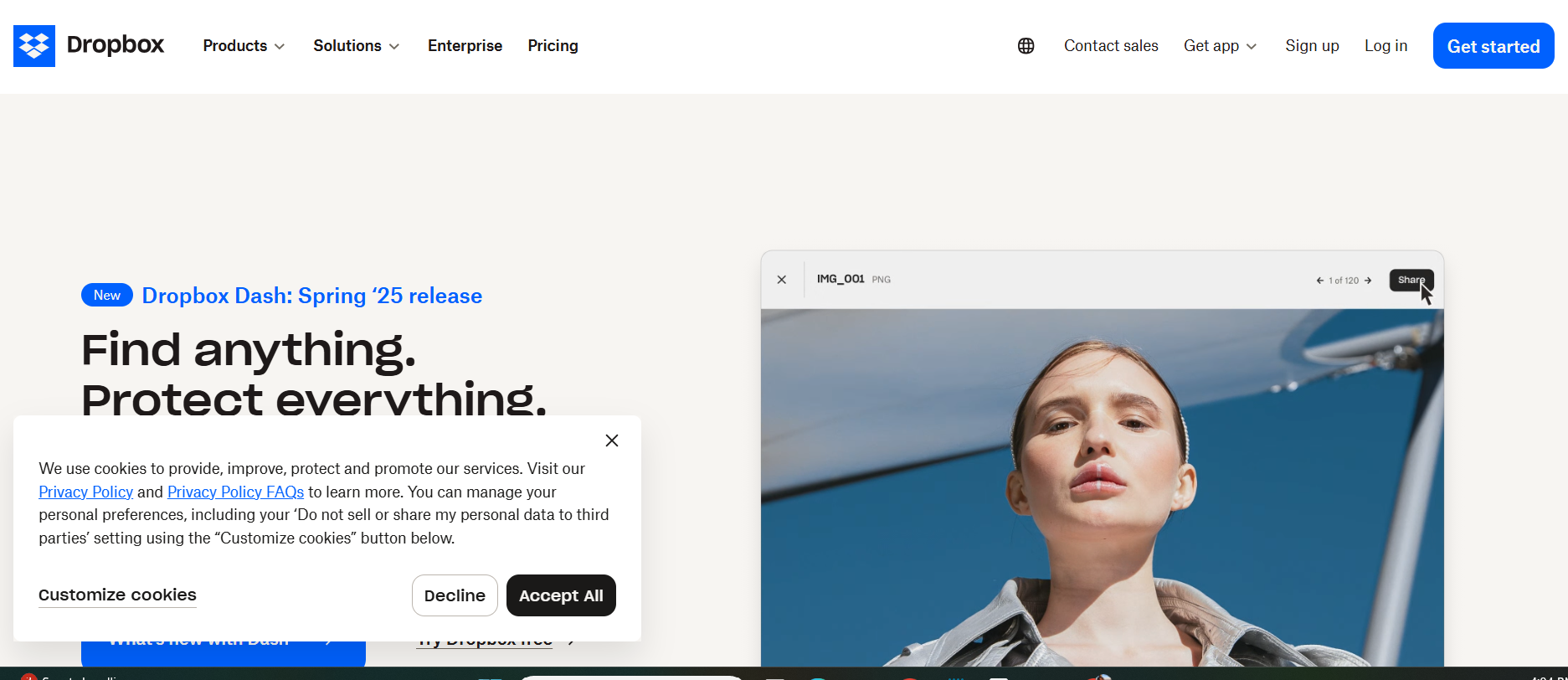
Dropbox Landing Page Key Features
- Cloud storage with automatic syncing across devices
- Dropbox Paper for collaborative documents and meeting notes
- File requests, version control, and smart previews
- eSignature support and secure file sharing
User Experience
Dropbox is widely praised for its reliable sync and file versioning. It’s especially useful for teams that handle large media files, design assets, or client deliverables.
-
Microsoft OneDrive + Office 365
OneDrive, combined with Microsoft Office 365, delivers robust document storage and collaboration inside the familiar Microsoft ecosystem.

Microsoft OneDrive Landing Page Key Features
- Cloud access and auto-syncing for Word, Excel, and PowerPoint files
- Co-authoring in real time through a browser or desktop apps
- Deep integration with Teams, Outlook, and SharePoint
- Access control, password-protected sharing, and file expiration
User Experience
For businesses already using Microsoft tools, OneDrive is a natural extension. The tight integration with Teams and Outlook makes file collaboration effortless.
-
Zoho WorkDrive
Zoho WorkDrive is a secure, team-centric file management platform designed for organized collaboration and structured storage across departments.
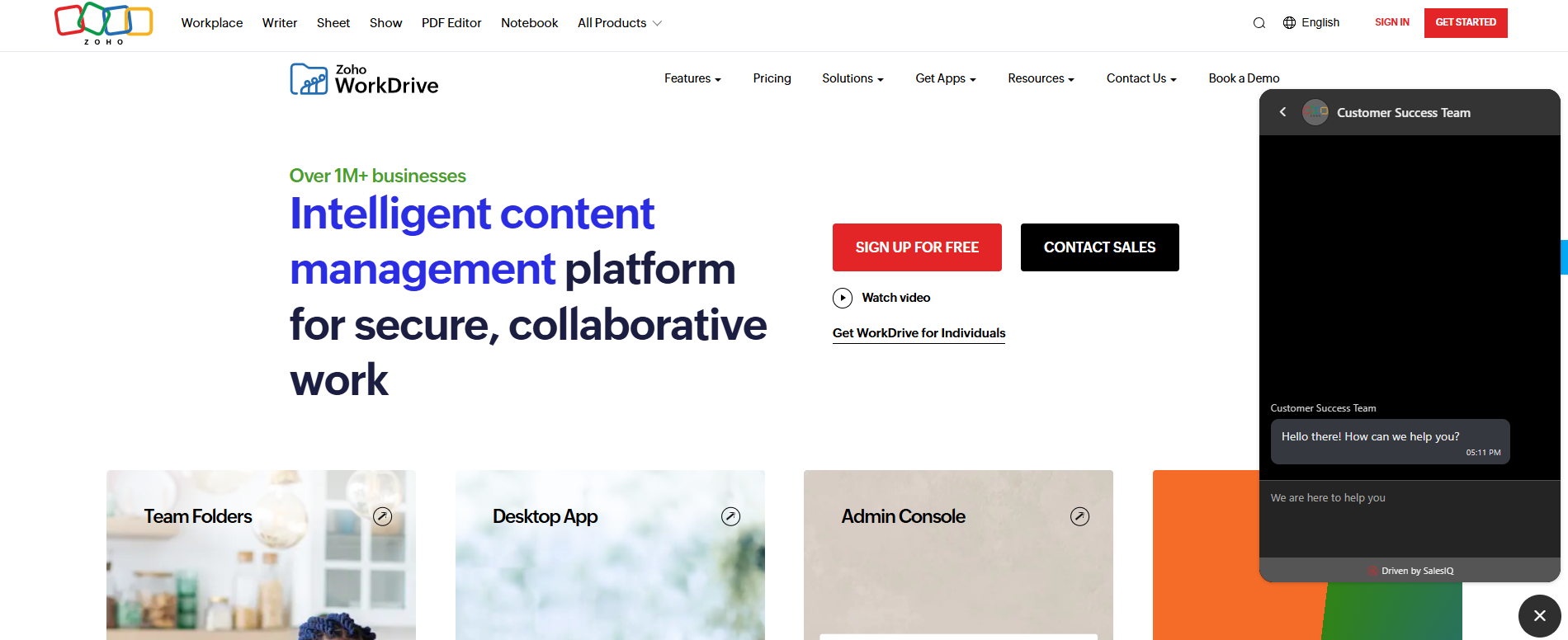
Zoho Workdrive Landing Page Key Features
- Team folders with role-based access and granular permissions
- Integrated office suite for documents, spreadsheets, and presentations
- Activity tracking, version history, and audit trails
- Offline mode, desktop sync, and mobile apps
User Experience
Zoho WorkDrive excels in structured team environments. It’s a great fit for businesses using other Zoho apps like CRM, Projects, or HR tools.
Leading SaaS Tools for E-commerce and Online Store Management
SaaS platforms have made launching and scaling e-commerce businesses significantly easier, offering end-to-end solutions that handle everything from storefront design to inventory, shipping, and marketing.
Below are five top-tier SaaS tools that stand out in the e-commerce space for their innovation, usability, and growth potential.
-
Shopify
Shopify is one of the most widely used ecommerce platforms globally, offering everything needed to build, manage, and scale an online store.
From solopreneurs to enterprise retailers, Shopify accommodates all business sizes.

Shopify Landing Page Key Features
- Drag-and-drop store builder with mobile-optimized themes
- Built-in payment gateway (Shopify Payments) and over 100 third-party options
- Powerful inventory, order, and shipping management
- App store with 8,000+ integrations for marketing, SEO, subscriptions, and more
User Experience
Shopify is praised for its ease of use and scalability. Store owners can launch within hours without needing coding expertise. Its backend is intuitive, while its app ecosystem makes it endlessly customizable.
-
BigCommerce
BigCommerce is a robust SaaS platform known for its flexibility and scalability, especially for mid-market and enterprise retailers.
It supports complex catalogs and multichannel selling with ease.

BigCommerce Landing Page Key Features
- Fully hosted store builder with enterprise-grade performance
- Support for B2B and B2C selling within a single storefront
- Headless commerce architecture for advanced customizations
- Built-in SEO features, abandoned cart recovery, and discount engines
User Experience
BigCommerce is ideal for merchants who’ve outgrown entry-level platforms and need more control without moving to custom builds. It supports heavy product catalogs and unique pricing tiers for different customer groups.
-
WooCommerce
WooCommerce is a powerful, open-source e-commerce plugin built for WordPress.
It turns any WordPress site into a fully functioning online store and offers unmatched flexibility for developers and content-driven brands.
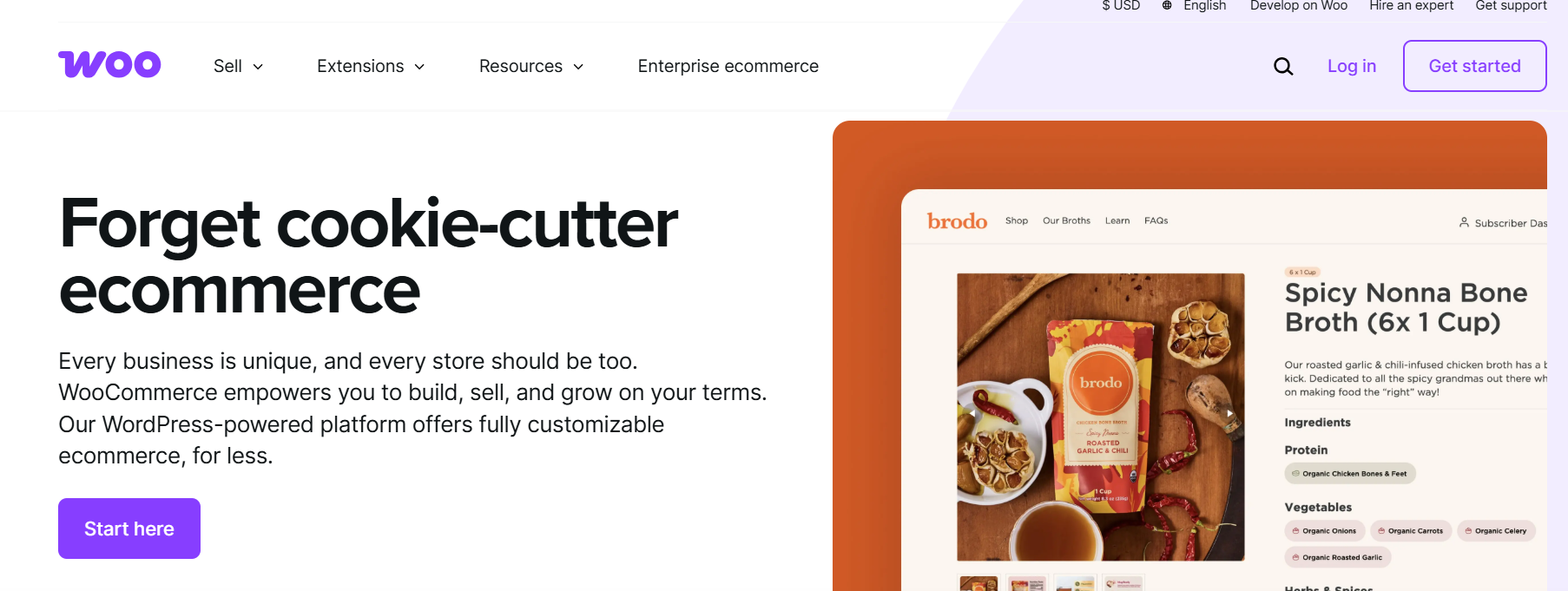
WooCommerce Landing Page Key Features
- Deep WordPress integration for content and commerce in one
- Complete control over store functionality and customization
- Supports physical, digital, and subscription-based products
- Large extension library for payment gateways, shipping, and marketing
User Experience
WooCommerce is favored by users who want ownership and customization flexibility. It’s especially suitable for content-first brands like bloggers, publishers, and niche retailers.
-
Wix eCommerce
Wix eCommerce offers a highly visual and beginner-friendly platform for building online stores.
It’s perfect for creative entrepreneurs and small businesses that want to combine striking design with practical ecommerce features.
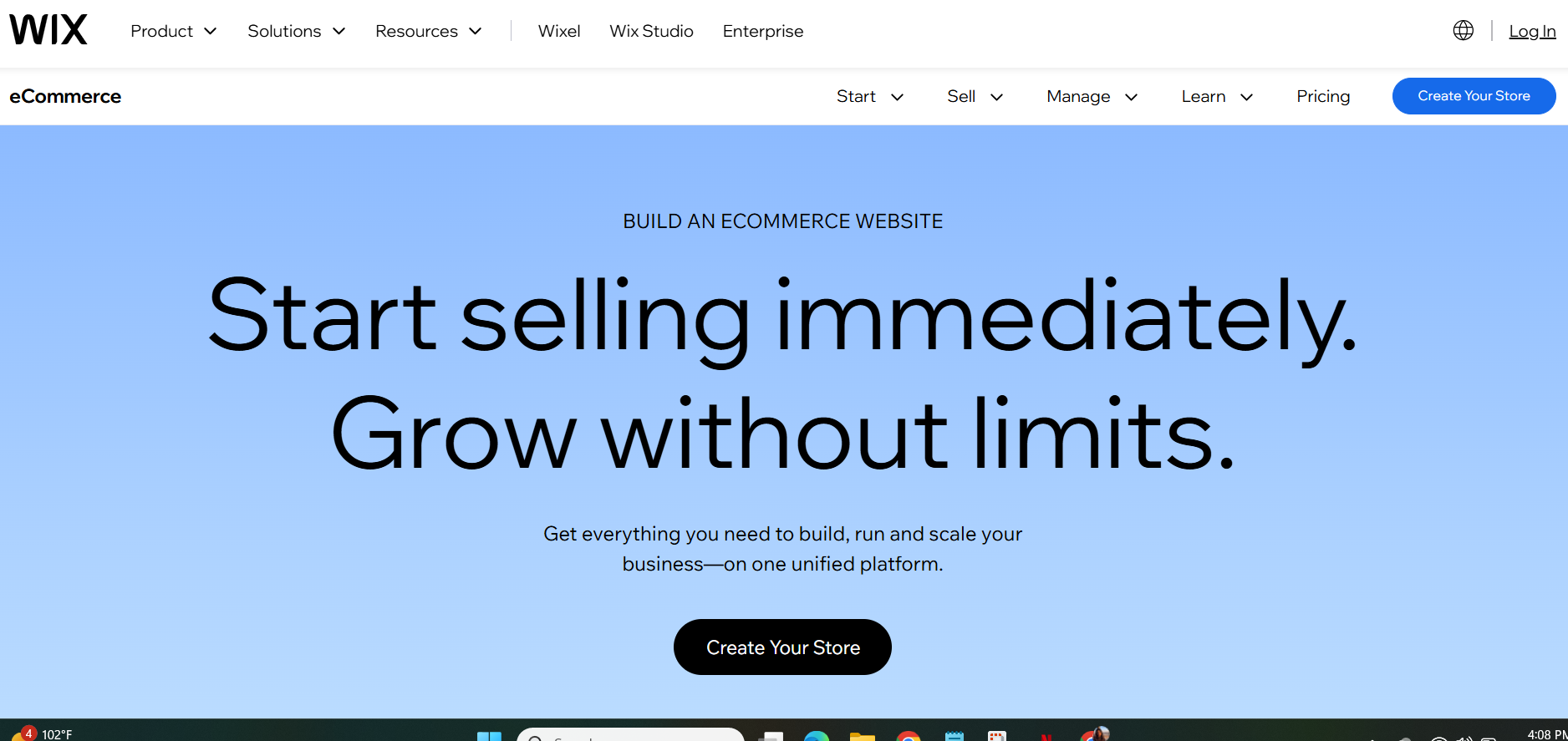
Wix Ecommerce Landing Page Key Features
- Drag-and-drop website builder with e-commerce modules
- Customizable product pages, galleries, and checkout flows
- Native SEO tools, email marketing, and blogging features
- Inventory management, shipping integrations, and payment options
- Mobile optimization and real-time analytics
User Experience
Wix is ideal for small shops and individual creators selling digital downloads, art, apparel, or services. Users love its creative freedom and ease of customization.
-
Squarespace Commerce
Squarespace Commerce brings polished design and e-commerce together for businesses that prioritize visual branding.
It’s especially useful for creative professionals, boutique retailers, and service providers.

Squarespace Landing Page Key Features
- Designer-quality templates with full mobile responsiveness
- Built-in e-commerce engine for selling products and services
- Inventory and order management, tax tools, and discount engine
- Integrated marketing tools like email campaigns and pop-ups
- Subscriptions, memberships, and digital downloads are supported.
User Experience
Squarespace is known for aesthetic excellence and simplicity. Users can quickly build elegant storefronts with minimal effort. It’s well-suited for sellers who want a clean, content-forward store without technical fuss.
CTA: Sick of Overpriced Tools With Underwhelming Features?
Get scheduling, analytics, team collaboration, and AI features in one value-packed plan. Social Champ delivers more, without the premium price tag.
Top SaaS Content Management Systems
SaaS-based CMS platforms make content creation, editing, publishing, and optimization accessible to teams of all sizes, without the overhead of hosting or security management.
Here are five leading CMS platforms that stand out for their performance, flexibility, and user experience.
-
WordPress.com
WordPress.com is the fully managed SaaS version of WordPress, offering users all the power of the world’s most popular CMS without the hassle of self-hosting.
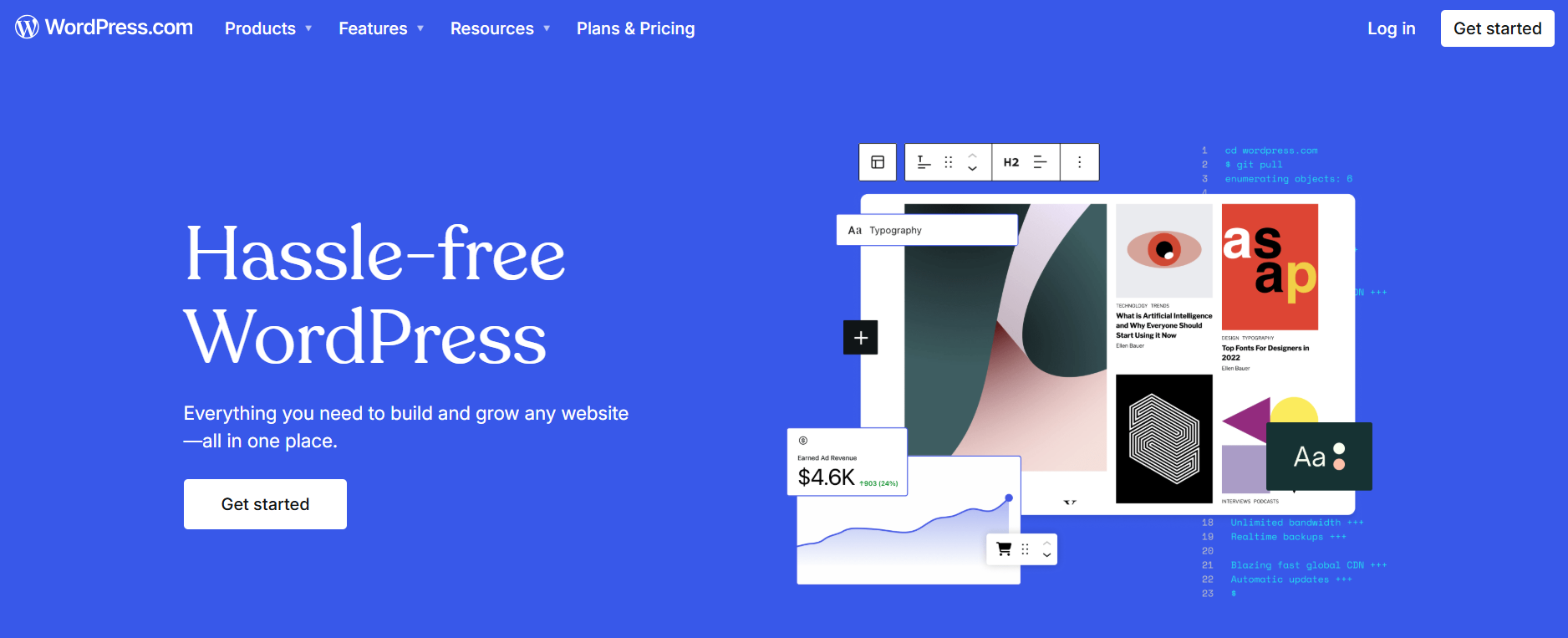
WordPress Landing Page Key Features
- Intuitive block editor for content creation and page layout
- Managed hosting, security, backups, and performance optimization
- Wide selection of themes and plugin support (with Business plan and above)
- Built-in SEO tools, social sharing, and Jetpack analytics
- E-commerce capabilities through WooCommerce integration
User Experience
WordPress.com provides a solid mix of ease of use and customization. Beginners can launch a professional site in hours, while advanced users can access deeper tools for design and SEO.
-
Webflow
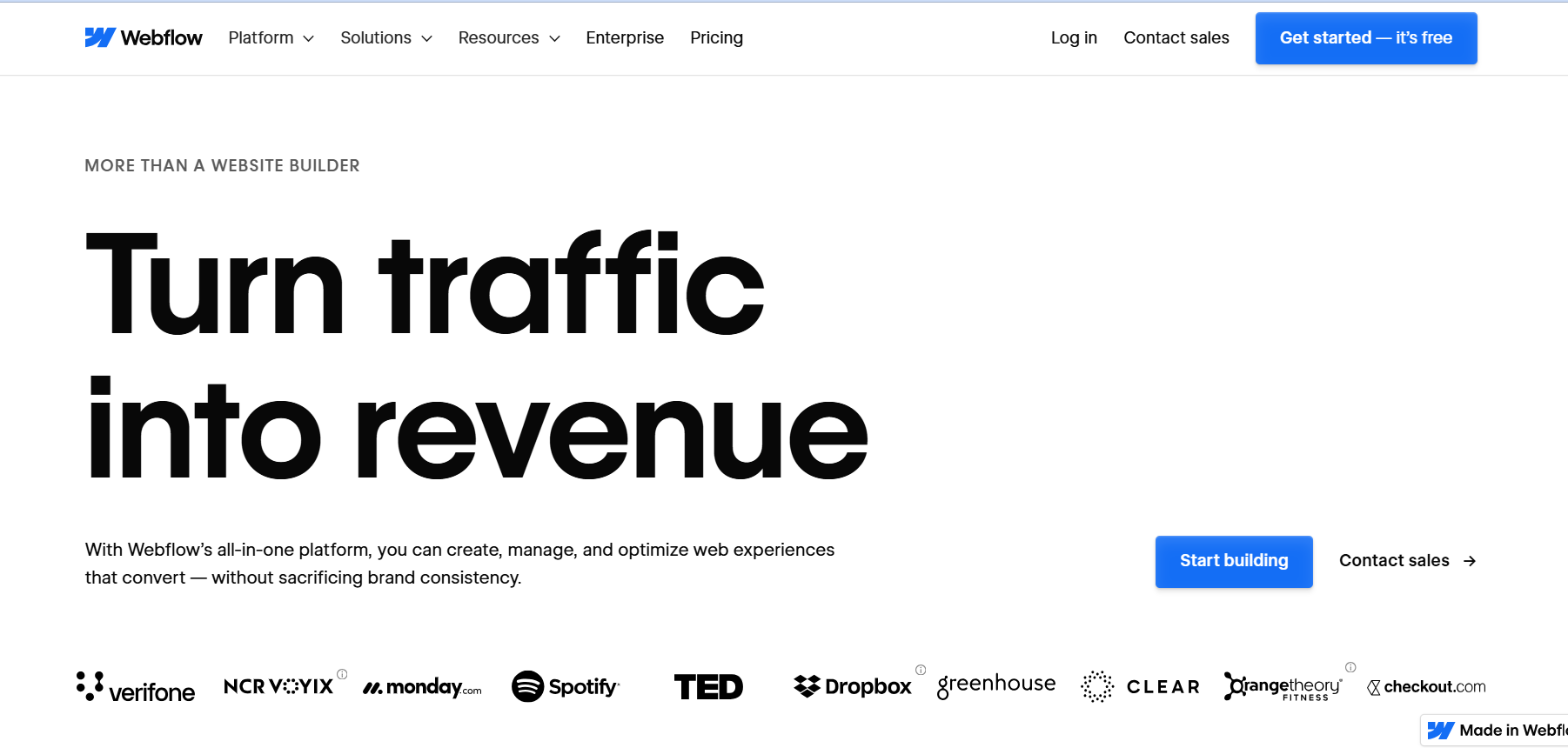
Webflow Landing Page Webflow is a visual CMS and website builder that combines the flexibility of custom code with the ease of a no-code platform, making it popular among designers and marketers.
Key Features
- Visual designer with granular control over CSS, layout, and interactions
- Built-in CMS for blog content, case studies, or product catalogs
- Hosting on a fast, global CDN with SSL and backups
- Dynamic content structures with API access
- Editor mode for clients and non-designers
User Experience
Webflow is a favorite for those who want design precision without touching code. Teams use it to build stunning marketing sites, landing pages, and dynamic content layouts. The CMS functionality is robust, and the editor UI is intuitive for content teams.
-
Contentful
Contentful is a headless CMS designed for developers and enterprise teams that want to manage content separately from the presentation layer.
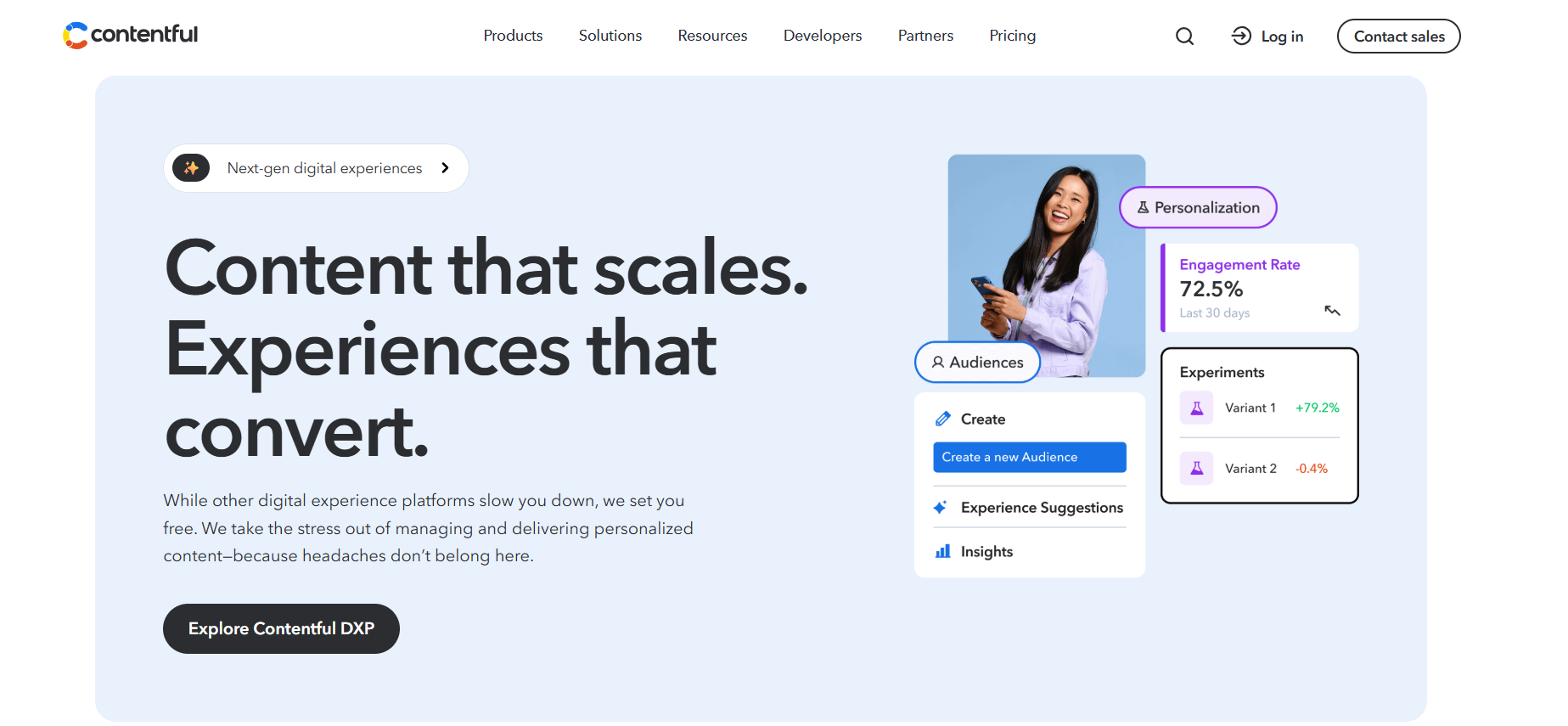
Contentful Landing Page Key Features
- Headless architecture for content delivery to web, mobile, and apps
- API-first approach with GraphQL and REST APIs
- Rich text editor with modular content modeling
- Role-based permissions and localization tools
- Scalable infrastructure for enterprise-level use
User Experience
Contentful is powerful, but it’s not plug-and-play. Development teams appreciate its flexibility and performance, especially when building multi-platform digital experiences. Marketers can work within a clean editor while developers control how and where the content appears.
-
Ghost
Ghost is a modern, open-source SaaS CMS focused on publishing and content monetization.
It’s particularly favored by independent creators, publishers, and membership-based businesses.
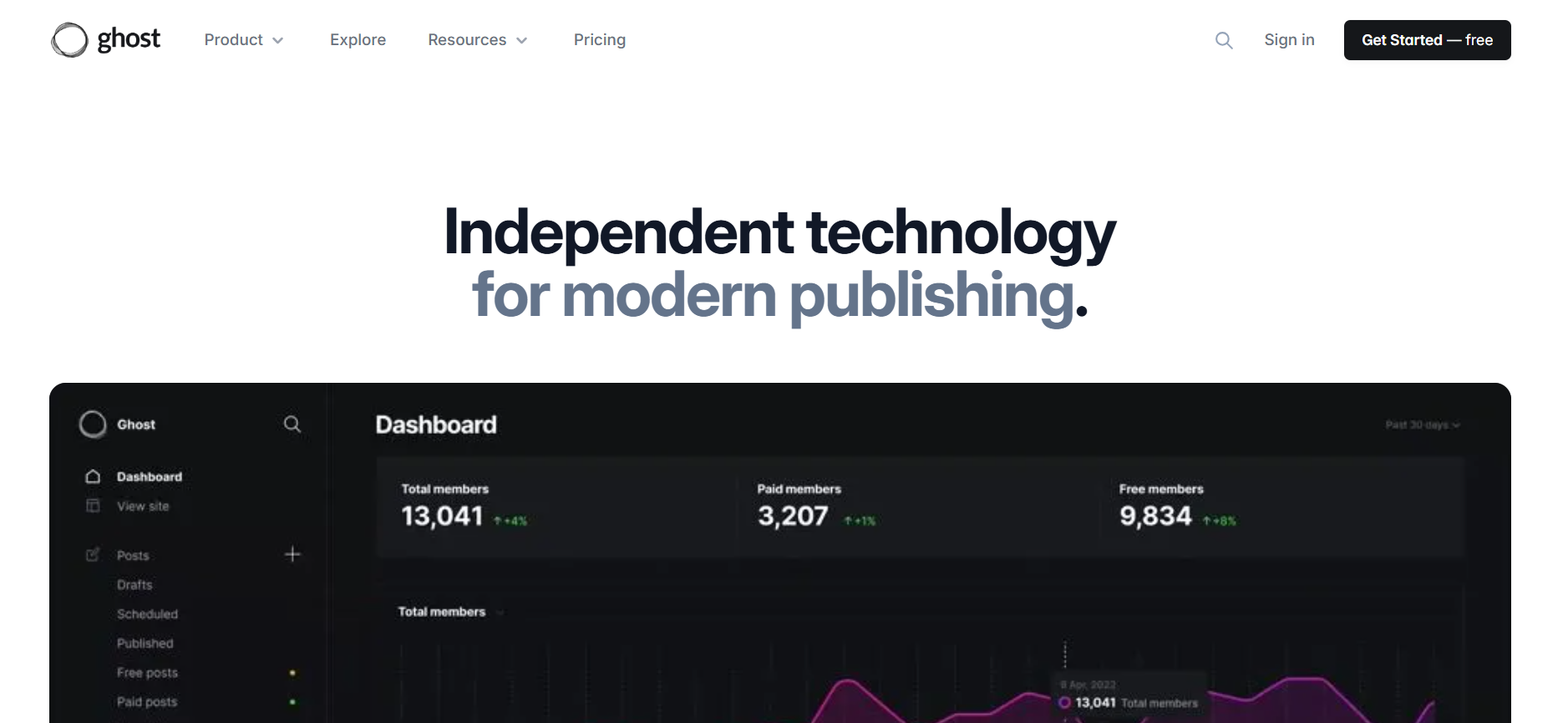
Ghost Landing Page Key Features
- Clean, distraction-free editor with Markdown support
- Membership and subscription features are built in.
- SEO, email newsletters, and integrations with Stripe, Zapier, and more
- Fast performance with built-in CDN and caching
- Headless capabilities for custom frontends
User Experience
Ghost offers an elegant, fast, and focused experience for writers and content-focused brands. Unlike bloated CMS platforms, it prioritizes speed, simplicity, and conversion. The ability to publish, email, and monetize from one place makes it a standout for modern creators and newsletters.
-
Wix
Wix offers a beginner-friendly CMS with a drag-and-drop interface, making it one of the most accessible platforms for small businesses and solopreneurs.
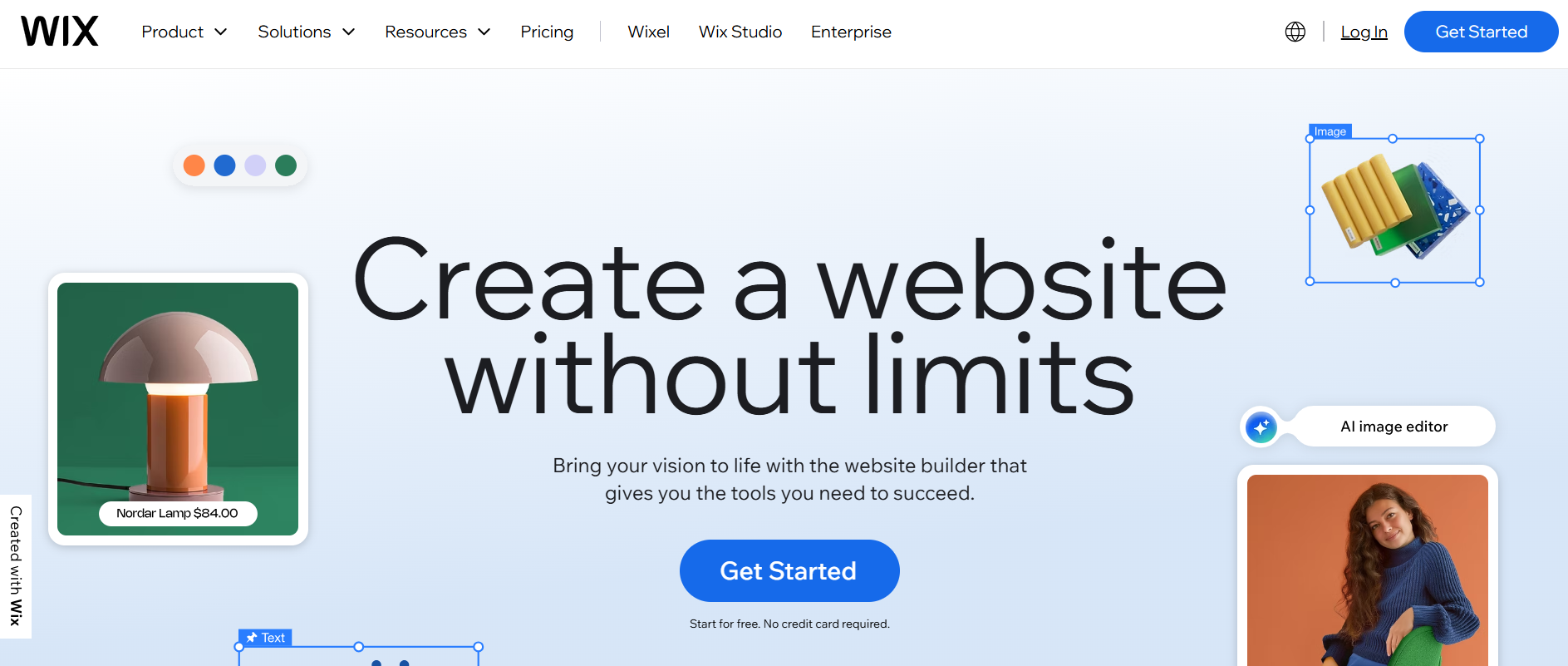
Wix Landing Page Key Features
- Visual builder with customizable templates
- Blog, gallery, and product management tools
- SEO wizard, social media integrations, and analytics
- An app market with tools for bookings, forms, and live chat
- Secure cloud hosting and mobile optimization
User Experience
Wix is ideal for users who want a fast, no-code solution to launch a website or blog. It’s especially effective for personal brands, small service businesses, and creatives. The interface is intuitive, and the built-in features reduce the need for third-party tools.
Why Social Champ Deserves a Spot in Your SaaS Stack
Social Champ is a powerful social media management tool designed to simplify and automate content workflows across platforms like Facebook, LinkedIn, Instagram, X (Twitter), Pinterest, and TikTok.
It offers a clean, intuitive dashboard for scheduling, analyzing, and repurposing posts with AI-enhanced support.
Features like bulk upload, auto-RSS, post recycling, and an intelligent content calendar make it ideal for both solo creators and teams.
Social Champ also supports workspace-level access control, approval workflows, and white-labeled reports, making it agency-ready.
Whether you’re managing one brand or twenty, it removes the hassle of scattered tools and manual posting. In short, it delivers everything you need to grow consistently and strategically, without any hassle.
Conclusion
Running a business today means doing more with less—less time, fewer manual tasks, and fewer scattered tools.
The right SaaS platforms help you stay organized, automate your work, and improve how your team runs every day.
Whether it’s handling payroll, managing projects, tracking customer support, or analyzing data, these tools are built to make business easier and more efficient.
Each tool in this list solves a specific problem, so think about where your business struggles the most, and start there.
The right setup can save you hours, cut costs, and help your team work better together.
If social media is one of your priorities, try Social Champ.
It lets you plan, schedule, and analyze all your posts from one place, so you can grow your brand without wasting time switching between platforms.
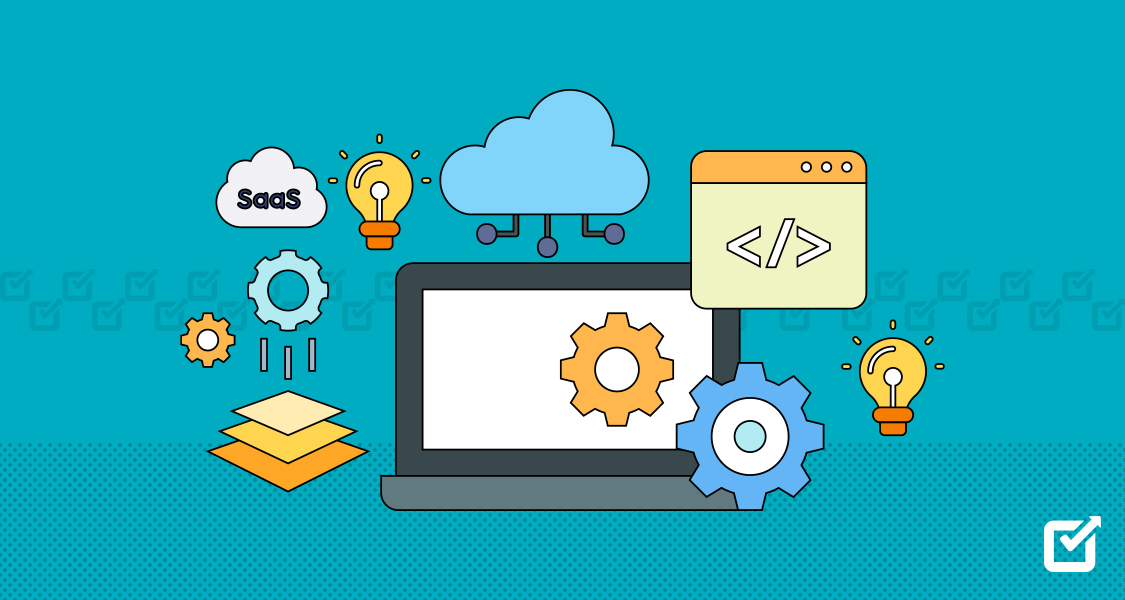


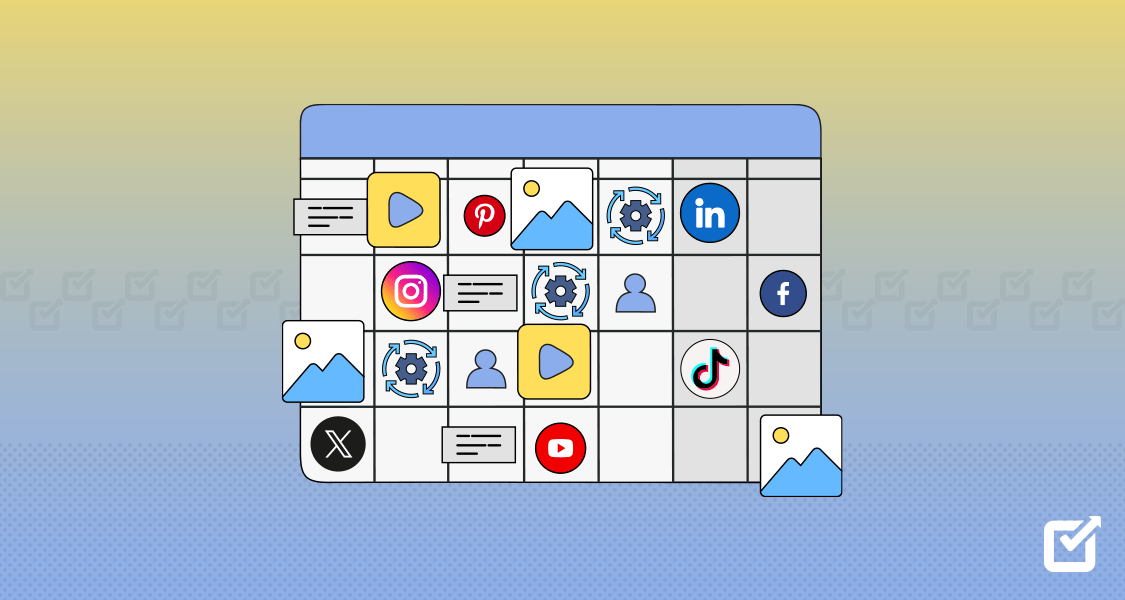
4 comments
Eliza Stark
Thanks for sharing this comprehensive list of SaaS tools! from project management to marketing automation to customer service. There’s definitely something for every type of business, no matter the size or industry.
Vincent Ryan
Awesome stuff, you summed up really well, glad I got the ultimate list of Saas tools in a single post.
Emma Chandler
Very comprehensive listing of tools, looking forward to implement content management tools to help manage content for my business.
Menessa Nathan
Woah, that is some commendable research on SaaS tools. Indeed businesses can see remarkable growth with SaaS accompanying them.